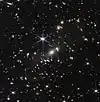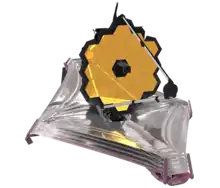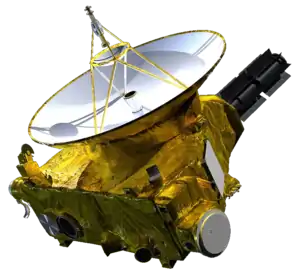NASA
The National Aeronautics and Space Administration (NASA /ˈnæsə/) is an independent agency of the US federal government responsible for the civil space program, aeronautics research, and space research.[note 1]
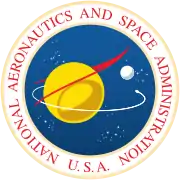 NASA seal | |
 NASA "meatball" and "worm" insignias | |
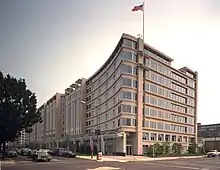 NASA headquarters in Washington, D.C. | |
| Agency overview | |
|---|---|
| Abbreviation | NASA |
| Formed | July 29, 1958 |
| Preceding agency |
|
| Type | Space agency Aeronautics research agency |
| Jurisdiction | United States Federal Government |
| Headquarters | Washington, D.C. 38°52′59″N 77°0′59″W |
| Motto | Exploring the secrets of the universe for the benefit of all [2] |
| Bill Nelson | |
| Deputy Administrator | Pamela Melroy |
| Primary spaceports | |
| Employees | 17,960 (2022)[3] |
| Annual budget | |
| Website | NASA.gov |
| Part of a series on the |
| United States Space Program |
|---|
  |
|
NASA was established in 1958, succeeding the National Advisory Committee for Aeronautics (NACA), to give the U.S. space development effort a distinctly civilian orientation, emphasizing peaceful applications in space science.[7][8][9] Since its establishment, most American space exploration efforts have been led by NASA, including the Apollo Moon landing missions, the Skylab space station, and later the Space Shuttle. NASA supports the International Space Station and oversees the development of the Orion spacecraft, the Space Launch System, Commercial Crew vehicles, and the planned Lunar Gateway space station. The agency is also responsible for the Launch Services Program, which provides oversight of launch operations and countdown management for uncrewed NASA launches.
NASA's science is focused on better understanding Earth through the Earth Observing System;[10] advancing heliophysics through the efforts of the Science Mission Directorate's Heliophysics Research Program;[11] exploring bodies throughout the Solar System with advanced robotic spacecraft such as New Horizons;[12] and researching astrophysics topics, such as the Big Bang, through the Great Observatories and associated programs.[13]
Management
Leadership
.jpg.webp)
The agency's administration is located at NASA Headquarters in Washington, DC, and provides overall guidance and direction.[14] Except under exceptional circumstances, NASA civil service employees are required to be US citizens.[15] NASA's administrator is nominated by the President of the United States subject to the approval of the US Senate,[16] and serves at the President's pleasure as a senior space science advisor. The current administrator is Bill Nelson, appointed by President Joe Biden, since May 3, 2021.[17]
Strategic Plan
NASA operates with four FY2022 strategic goals.[18]
- Expand human knowledge through new scientific discoveries
- Extend human presence to the Moon and on towards Mars for sustainable long-term exploration, development, and utilization
- Catalyze economic growth and drive innovation to address national challenges
- Enhance capabilities and operations to catalyze current and future mission success
Budget
NASA budget requests are developed by NASA and approved by the administration prior to submission to the U.S. Congress. Authorized budgets are those that have been included in enacted appropriations bills that are approved by both houses of Congress and enacted into law by the U.S. president.[19]
NASA fiscal year budget requests and authorized budgets are provided below.
| Year | Budget Request in bil. US$ |
Authorized Budget in bil. US$ |
U.S. Government Employees |
|---|---|---|---|
| 2018 | $19.092[20] | $20.736[21] | 17,551[22] |
| 2019 | $19.892[21] | $21.500[23] | 17,551[24] |
| 2020 | $22.613[23] | $22.629[25] | 18,048[26] |
| 2021 | $25.246[25] | $23.271[27] | 18,339[28] |
| 2022 | $24.802[27] | $24.041[29] | 18,400 est |
Organization
NASA funding and priorities are developed through its six Mission Directorates.
| Mission Directorate | Associate Administrator | % of NASA Budget (FY22)[27] |
|---|---|---|
| Aeronautics Research (ARMD) | Robert A. Pearce[30] | 4% |
| Exploration Systems Development (ESDMD) | James Free[31] | 28% |
| Space Operations (SOMD) | Kathy Lueders[31] | 17% |
| Science (SMD) | Thomas Zurbuchen[32] | 32% |
| Space Technology (STMD) | James L. Reuter[33] | 5% |
| Mission Support (MSD) | Robert Gibbs[34] | 14% |
Center-wide activities such as the Chief Engineer and Safety and Mission Assurance organizations are aligned to the headquarters function. The MSD budget estimate includes funds for these HQ functions. The administration operates 10 major field centers with several managing additional subordinate facilities across the country. Each is led by a Center Director (data below valid as of September 1, 2022).
| Field Center | Primary Location | Center Director |
|---|---|---|
| Ames Research Center | Mountain View, California | Dr. Eugene L. Tu[35] |
| Armstrong Flight Research Center | Palmdale, California | Brad Flick (acting)[36] |
| Glenn Research Center | Cleveland, Ohio | Dr. James A. Kenyon (acting)[37] |
| Goddard Space Flight Center | Greenbelt, Maryland | Dennis J. Andrucyk[38] |
| Jet Propulsion Laboratory | La Canada-Flintridge, California | Laurie Leshin[39] |
| Johnson Space Center | Houston, Texas | Vanessa E. Wyche[40] |
| Kennedy Space Center | Merritt Island, Florida | Janet Petro[41] |
| Langley Research Center | Hampton, Virginia | Clayton Turner[42] |
| Marshall Space Flight Center | Huntsville, Alabama | Jody Singer[43] |
| Stennis Space Center | Hancock County, Mississippi | Richard J. Gilbrech[44] |
History
Establishment of NASA
Beginning in 1946, the National Advisory Committee for Aeronautics (NACA) began experimenting with rocket planes such as the supersonic Bell X-1.[45] In the early 1950s, there was challenge to launch an artificial satellite for the International Geophysical Year (1957–1958). An effort for this was the American Project Vanguard. After the Soviet space program's launch of the world's first artificial satellite (Sputnik 1) on October 4, 1957, the attention of the United States turned toward its own fledgling space efforts. The US Congress, alarmed by the perceived threat to national security and technological leadership (known as the "Sputnik crisis"), urged immediate and swift action; President Dwight D. Eisenhower counseled more deliberate measures. The result was a consensus that the White House forged among key interest groups, including scientists committed to basic research; the Pentagon which had to match the Soviet military achievement; corporate America looking for new business; and a strong new trend in public opinion looking up to space exploration.[46]
On January 12, 1958, NACA organized a "Special Committee on Space Technology," headed by Guyford Stever.[9] On January 14, 1958, NACA Director Hugh Dryden published "A National Research Program for Space Technology," stating,[47]
It is of great urgency and importance to our country both from consideration of our prestige as a nation as well as military necessity that this challenge [Sputnik] be met by an energetic program of research and development for the conquest of space ... It is accordingly proposed that the scientific research be the responsibility of a national civilian agency ... NACA is capable, by rapid extension and expansion of its effort, of providing leadership in space technology.[47]
While this new federal agency would conduct all non-military space activity, the Advanced Research Projects Agency (ARPA) was created in February 1958 to develop space technology for military application.[48]
On July 29, 1958, Eisenhower signed the National Aeronautics and Space Act, establishing NASA.[49] When it began operations on October 1, 1958, NASA absorbed the 43-year-old NACA intact; its 8,000 employees, an annual budget of US$100 million, three major research laboratories (Langley Aeronautical Laboratory, Ames Aeronautical Laboratory, and Lewis Flight Propulsion Laboratory) and two small test facilities.[50] Elements of the Army Ballistic Missile Agency and the United States Naval Research Laboratory were incorporated into NASA. A significant contributor to NASA's entry into the Space Race with the Soviet Union was the technology from the German rocket program led by Wernher von Braun, who was now working for the Army Ballistic Missile Agency (ABMA), which in turn incorporated the technology of American scientist Robert Goddard's earlier works.[51] Earlier research efforts within the US Air Force[50] and many of ARPA's early space programs were also transferred to NASA.[52] In December 1958, NASA gained control of the Jet Propulsion Laboratory, a contractor facility operated by the California Institute of Technology.[50]
Past Administrators
NASA's first administrator was Dr. T. Keith Glennan who was appointed by President Dwight D. Eisenhower. During his term (1958–1961) he brought together the disparate projects in American space development research.[53] James Webb led the agency during the development of the Apollo program in the 1960s.[54] James C. Fletcher has held the position twice; first during the Nixon administration in the 1970s and then at the request of Ronald Reagan following the Challenger disaster.[55] Daniel Goldin held the post for nearly 10 years and is the longest serving administrator to date. He is best known for pioneering the "faster, better, cheaper" approach to space programs.[56] Bill Nelson is currently serving as the 14th administrator of NASA.
Insignia
The NASA seal was approved by Eisenhower in 1959, and slightly modified by President John F. Kennedy in 1961.[57][58] NASA's first logo was designed by the head of Lewis' Research Reports Division, James Modarelli, as a simplification of the 1959 seal.[59] In 1975, the original logo was first dubbed "the meatball" to distinguish it from the newly designed "worm" logo which replaced it. The "meatball" returned to official use in 1992.[59] The "worm" was brought out of retirement by administrator Jim Bridenstine in 2020.[60]
Facilities
NASA Headquarters in Washington, DC provides overall guidance and political leadership to the agency's ten field centers, through which all other facilities are administered.[61]
Ames Research Center (ARC) at Moffett Field is located in the Silicon Valley of central California and delivers wind-tunnel research on the aerodynamics of propeller-driven aircraft along with research and technology in aeronautics, spaceflight, and information technology.[62] It provides leadership in astrobiology, small satellites, robotic lunar exploration, intelligent/adaptive systems and thermal protection.
Armstrong Flight Research Center (AFRC) is located inside Edwards Air Force Base and is the home of the Shuttle Carrier Aircraft (SCA), a modified Boeing 747 designed to carry a Space Shuttle orbiter back to Kennedy Space Center after a landing at Edwards AFB. The center focuses on flight testing of advanced aerospace systems.
Glenn Research Center is based in Cleveland, Ohio and focuses on air-breathing and in-space propulsion and cryogenics, communications, power energy storage and conversion, microgravity sciences, and advanced materials.[63]
Goddard Space Flight Center (GSFC), located in Greenbelt, Maryland develops and operates uncrewed scientific spacecraft.[64] GSFC also operates two spaceflight tracking and data acquisition networks (the Space Network and the Near Earth Network), develops and maintains advanced space and Earth science data information systems, and develops satellite systems for the National Oceanic and Atmospheric Administration (NOAA).[64]
Johnson Space Center (JSC) is the NASA center for human spaceflight training, research and flight control.[65] It is home to the United States Astronaut Corps and is responsible for training astronauts from the US and its international partners, and includes the Christopher C. Kraft Jr. Mission Control Center.[66] JSC also operates the White Sands Test Facility in Las Cruces, New Mexico to support rocket testing.
Jet Propulsion Laboratory (JPL), located in the San Gabriel Valley area of Los Angeles County, C and builds and operates robotic planetary spacecraft, though it also conducts Earth-orbit and astronomy missions.[67] It is also responsible for operating NASA's Deep Space Network (DSN).
Langley Research Center (LaRC), located in Hampton, Virginia devotes two-thirds of its programs to aeronautics, and the rest to space. LaRC researchers use more than 40 wind tunnels to study improved aircraft and spacecraft safety, performance, and efficiency. The center was also home to early human spaceflight efforts including the team chronicled in the Hidden Figures story.[68]
Kennedy Space Center (KSC), located west of Cape Canaveral Space Force Station in Florida, has been the launch site for every United States human space flight since 1968. KSC also manages and operates uncrewed rocket launch facilities for America's civil space program from three pads at Cape Canaveral.[69]
Marshall Space Flight Center (MSFC), located on the Redstone Arsenal near Huntsville, Alabama, is one of NASA's largest centers and is leading the development of the Space Launch System in support of the Artemis program. Marshall is NASA's lead center for International Space Station (ISS) design and assembly; payloads and related crew training; and was the lead for Space Shuttle propulsion and its external tank.[70]
Stennis Space Center, originally the "Mississippi Test Facility", is located in Hancock County, Mississippi, on the banks of the Pearl River at the Mississippi–Louisiana border.[71] Commissioned in October 1961, it is currently used for rocket testing by over 30 local, state, national, international, private, and public companies and agencies.[72][73] It also contains the NASA Shared Services Center.[74]
X-15 (1954–1968)

NASA inherited NACA's X-15 experimental rocket-powered hypersonic research aircraft, developed in conjunction with the US Air Force and Navy. Three planes were built starting in 1955. The X-15 was drop-launched from the wing of one of two NASA Boeing B-52 Stratofortresses, NB52A tail number 52-003, and NB52B, tail number 52-008 (known as the Balls 8). Release took place at an altitude of about 45,000 feet (14 km) and a speed of about 500 miles per hour (805 km/h).[75]
Twelve pilots were selected for the program from the Air Force, Navy, and NACA. A total of 199 flights were made between June 1959 and December 1968, resulting in the official world record for the highest speed ever reached by a crewed powered aircraft (current as of 2014), and a maximum speed of Mach 6.72, 4,519 miles per hour (7,273 km/h).[76] The altitude record for X-15 was 354,200 feet (107.96 km).[77] Eight of the pilots were awarded Air Force astronaut wings for flying above 260,000 feet (80 km), and two flights by Joseph A. Walker exceeded 100 kilometers (330,000 ft), qualifying as spaceflight according to the International Aeronautical Federation. The X-15 program employed mechanical techniques used in the later crewed spaceflight programs, including reaction control system jets for controlling the orientation of a spacecraft, space suits, and horizon definition for navigation.[77] The reentry and landing data collected were valuable to NASA for designing the Space Shuttle.[78]
Mercury (1958–1963)

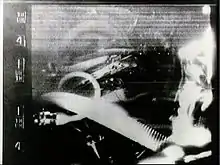
In 1958, NASA formed an engineering group, the Space Task Group, to manage their human spaceflight programs under the direction of Robert Gilruth. Their earliest programs were conducted under the pressure of the Cold War competition between the US and the Soviet Union. NASA inherited the US Air Force's Man in Space Soonest program, which considered many crewed spacecraft designs ranging from rocket planes like the X-15, to small ballistic space capsules.[79] By 1958, the space plane concepts were eliminated in favor of the ballistic capsule,[80] and NASA renamed it Project Mercury. The first seven astronauts were selected among candidates from the Navy, Air Force and Marine test pilot programs. On May 5, 1961, astronaut Alan Shepard became the first American in space aboard a capsule he named Freedom 7, launched on a Redstone booster on a 15-minute ballistic (suborbital) flight.[81] John Glenn became the first American to be launched into orbit, on an Atlas launch vehicle on February 20, 1962, aboard Friendship 7.[82] Glenn completed three orbits, after which three more orbital flights were made, culminating in L. Gordon Cooper's 22-orbit flight Faith 7, May 15–16, 1963.[83] Katherine Johnson, Mary Jackson, and Dorothy Vaughan were three of the human computers doing calculations on trajectories during the Space Race.[84][85][86] Johnson was well known for doing trajectory calculations for John Glenn's mission in 1962, where she was running the same equations by hand that were being run on the computer.[84]
Mercury's competition from the Soviet Union (USSR) was the single-pilot Vostok spacecraft. They sent the first man in space, cosmonaut Yuri Gagarin, into a single Earth orbit aboard Vostok 1 in April 1961, one month before Shepard's flight.[87] In August 1962, they achieved an almost four-day record flight with Andriyan Nikolayev aboard Vostok 3, and also conducted a concurrent Vostok 4 mission carrying Pavel Popovich.[88]
Gemini (1961–1966)
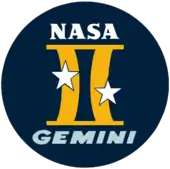

Based on studies to grow the Mercury spacecraft capabilities to long-duration flights, developing space rendezvous techniques, and precision Earth landing, Project Gemini was started as a two-man program in 1961 to overcome the Soviets' lead and to support the planned Apollo crewed lunar landing program, adding extravehicular activity (EVA) and rendezvous and docking to its objectives. The first crewed Gemini flight, Gemini 3, was flown by Gus Grissom and John Young on March 23, 1965.[89] Nine missions followed in 1965 and 1966, demonstrating an endurance mission of nearly fourteen days, rendezvous, docking, and practical EVA, and gathering medical data on the effects of weightlessness on humans.[90][91]
Under the direction of Soviet Premier Nikita Khrushchev, the USSR competed with Gemini by converting their Vostok spacecraft into a two- or three-man Voskhod. They succeeded in launching two crewed flights before Gemini's first flight, achieving a three-cosmonaut flight in 1964 and the first EVA in 1965.[92] After this, the program was canceled, and Gemini caught up while spacecraft designer Sergei Korolev developed the Soyuz spacecraft, their answer to Apollo.
Apollo (1960–1972)

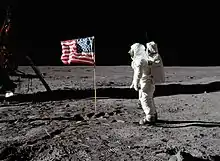
The U.S. public's perception of the Soviet lead in the Space Race (by putting the first man into space) motivated President John F. Kennedy[93] to ask the Congress on May 25, 1961, to commit the federal government to a program to land a man on the Moon by the end of the 1960s, which effectively launched the Apollo program.[94]
Apollo was one of the most expensive American scientific programs ever. It cost more than $20 billion in 1960s dollars[95] or an estimated $236 billion in present-day US dollars.[96] (In comparison, the Manhattan Project cost roughly $30.1 billion, accounting for inflation.)[96][97] The Apollo program used the newly developed Saturn I and Saturn V rockets, which were far larger than the repurposed ICBMs of the previous Mercury and Gemini programs.[98] They were used to launch the Apollo spacecraft, consisting of the Command and Service Module (CSM) and the Lunar Module (LM). The CSM ferried astronauts from Earth to Moon orbit and back, while the Lunar Module would land them on the Moon itself.[note 2]
The planned first crew of 3 astronauts were killed due to a fire during a 1967 preflight test for the Apollo 204 mission (later renamed Apollo 1).[99] The second crewed mission, Apollo 8, brought astronauts for the first time in a flight around the Moon in December 1968.[100] Shortly before, the Soviets had sent an uncrewed spacecraft around the Moon.[101] The next two missions (Apollo 9 and Apollo 10) practiced rendezvous and docking maneuvers required to conduct the Moon landing.[102][103]
The Apollo 11 mission, launched in July 1969, landed the first humans on the Moon. Astronauts Neil Armstrong and Buzz Aldrin walked on the lunar surface, conducting experiments and sample collection, while Michael Collins orbited above in the CSM.[104] Six subsequent Apollo missions (12 through 17) were launched; five of them were successful, while one (Apollo 13) was aborted after an in-flight emergency nearly killed the astronauts. Throughout these seven Apollo spaceflights, twelve men walked on the Moon. These missions returned a wealth of scientific data and 381.7 kilograms (842 lb) of lunar samples. Topics covered by experiments performed included soil mechanics, meteoroids, seismology, heat flow, lunar ranging, magnetic fields, and solar wind.[105] The Moon landing marked the end of the space race; and as a gesture, Armstrong mentioned mankind when he stepped down on the Moon.[106]
On July 3, 1969, the Soviets suffered a major setback on their moon program when the rocket known as the N-1 had exploded in a fireball at its launch site at Baikonur in Kazakhstan, destroying one of two launch pads. Each of the first four launches of N-1 resulted in failure before the end of the first stage flight effectively denying the Soviet Union the capacity to deliver the systems required for a crewed lunar landing.[107]
Apollo set major milestones in human spaceflight. It stands alone in sending crewed missions beyond low Earth orbit, and landing humans on another celestial body.[108] Apollo 8 was the first crewed spacecraft to orbit another celestial body, while Apollo 17 marked the last moonwalk and the last crewed mission beyond low Earth orbit. The program spurred advances in many areas of technology peripheral to rocketry and crewed spaceflight, including avionics, telecommunications, and computers. Apollo sparked interest in many fields of engineering and left many physical facilities and machines developed for the program as landmarks. Many objects and artifacts from the program are on display at various locations throughout the world, notably at the Smithsonian's Air and Space Museums.
Skylab (1965–1979)
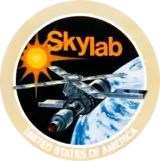
.jpg.webp)
Skylab was the United States' first and only independently built space station.[109] Conceived in 1965 as a workshop to be constructed in space from a spent Saturn IB upper stage, the 169,950 lb (77,088 kg) station was constructed on Earth and launched on May 14, 1973, atop the first two stages of a Saturn V, into a 235-nautical-mile (435 km) orbit inclined at 50° to the equator. Damaged during launch by the loss of its thermal protection and one electricity-generating solar panel, it was repaired to functionality by its first crew. It was occupied for a total of 171 days by 3 successive crews in 1973 and 1974.[109] It included a laboratory for studying the effects of microgravity, and a solar observatory.[109] NASA planned to have the in-development Space Shuttle dock with it, and elevate Skylab to a higher safe altitude, but the Shuttle was not ready for flight before Skylab's re-entry and demise on July 11, 1979.[110]
To reduce cost, NASA modified one of the Saturn V rockets originally earmarked for a canceled Apollo mission to launch Skylab, which itself was a modified Saturn V fuel tank. Apollo spacecraft, launched on smaller Saturn IB rockets, were used for transporting astronauts to and from the station. Three crews, consisting of three men each, stayed aboard the station for periods of 28, 59, and 84 days. Skylab's habitable volume was 11,290 cubic feet (320 m3), which was 30.7 times bigger than that of the Apollo Command Module.[110]
Space Transportation System (1969–1972)
In February 1969, President Richard Nixon appointed a space task group headed by Vice President Spiro Agnew to recommend human spaceflight projects beyond Apollo. The group responded in September with the Integrated Program Plan (IPP), intended to support space stations in Earth and lunar orbit, a lunar surface base, and a human Mars landing. These would be supported by replacing NASA's existing expendable launch systems with a reusable infrastructure including Earth orbit shuttles, space tugs, and a nuclear-powered trans-lunar and interplanetary shuttle. Despite the enthusiastic support of Agnew and NASA Administrator Thomas O. Paine, Nixon realized public enthusiasm, which translated into Congressional support, for the space program was waning as Apollo neared its climax, and vetoed most of these plans, except for the Earth orbital shuttle, and a deferred Earth space station.[111]
Apollo-Soyuz (1972–1975)
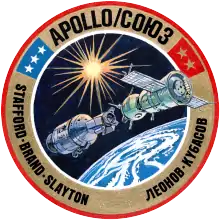

On May 24, 1972, US President Richard M. Nixon and Soviet Premier Alexei Kosygin signed an agreement calling for a joint crewed space mission, and declaring intent for all future international crewed spacecraft to be capable of docking with each other.[112] This authorized the Apollo-Soyuz Test Project (ASTP), involving the rendezvous and docking in Earth orbit of a surplus Apollo command and service module with a Soyuz spacecraft. The mission took place in July 1975. This was the last US human spaceflight until the first orbital flight of the Space Shuttle in April 1981.[113]
The mission included both joint and separate scientific experiments and provided useful engineering experience for future joint US–Russian space flights, such as the Shuttle–Mir program[114] and the International Space Station.
Space Shuttle (1972–2011)
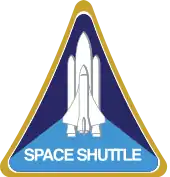

The Space Shuttle was the only vehicle in the Space Transportation System to be developed, and became the major focus of NASA in the late 1970s and the 1980s. Originally planned as a frequently launchable, fully reusable vehicle, the design was changed to use an expendable external propellant tank to reduce development cost, and four Space Shuttle orbiters were built by 1985. The first to launch, Columbia, did so on April 12, 1981, the 20th anniversary of the first human spaceflight.[115]
The Shuttle flew 135 missions and carried 355 astronauts from 16 countries, many on multiple trips. Its major components were a spaceplane orbiter with an external fuel tank and two solid-fuel launch rockets at its side. The external tank, which was bigger than the spacecraft itself, was the only major component that was not reused. The shuttle could orbit in altitudes of 185–643 km (115–400 miles)[116] and carry a maximum payload (to low orbit) of 24,400 kg (54,000 lb).[117] Missions could last from 5 to 17 days and crews could be from 2 to 8 astronauts.[116]
On 20 missions (1983–1998) the Space Shuttle carried Spacelab, designed in cooperation with the European Space Agency (ESA). Spacelab was not designed for independent orbital flight, but remained in the Shuttle's cargo bay as the astronauts entered and left it through an airlock.[118] On June 18, 1983, Sally Ride became the first American woman in space, on board the Space Shuttle Challenger STS-7 mission.[119] Another famous series of missions were the launch and later successful repair of the Hubble Space Telescope in 1990 and 1993, respectively.[120]
In 1995, Russian-American interaction resumed with the Shuttle–Mir missions (1995–1998). Once more an American vehicle docked with a Russian craft, this time a full-fledged space station. This cooperation has continued with Russia and the United States as two of the biggest partners in the largest space station built: the International Space Station (ISS).[121] The strength of their cooperation on this project was even more evident when NASA began relying on Russian launch vehicles to service the ISS during the two-year grounding of the shuttle fleet following the 2003 Space Shuttle Columbia disaster.
The Shuttle fleet lost two orbiters and 14 astronauts in two disasters: Challenger in 1986, and Columbia in 2003.[122] While the 1986 loss was mitigated by building the Space Shuttle Endeavour from replacement parts, NASA did not build another orbiter to replace the second loss.[122] NASA's Space Shuttle program had 135 missions when the program ended with the successful landing of the Space Shuttle Atlantis at the Kennedy Space Center on July 21, 2011. The program spanned 30 years with 355 separate astronauts sent into space, many on multiple missions.[123]
Constellation (2005–2010)

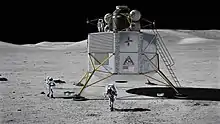
While the Space Shuttle program was still suspended after the loss of Columbia, President George W. Bush announced the Vision for Space Exploration including the retirement of the Space Shuttle after completing the International Space Station. The plan was enacted into law by the NASA Authorization Act of 2005 and directs NASA to develop and launch the Crew Exploration Vehicle (later called Orion) by 2010, return Americans to the Moon by 2020, land on Mars as feasible, repair the Hubble Space Telescope, and continue scientific investigation through robotic solar system exploration, human presence on the ISS, Earth observation, and astrophysics research. The crewed exploration goals prompted NASA's Constellation program.[124]
On December 4, 2006, NASA announced it was planning a permanent Moon base.[125] The goal was to start building the Moon base by 2020, and by 2024, have a fully functional base that would allow for crew rotations and in-situ resource utilization. However, in 2009, the Augustine Committee found the program to be on an "unsustainable trajectory."[126] In February 2010, President Barack Obama's administration proposed eliminating public funds for it.[127]
Journey to Mars (2010–2017)
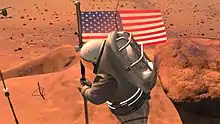
President Obama's plan was to develop American private spaceflight capabilities to get astronauts to the International Space Station, replace Russian Soyuz capsules, and use Orion capsules for ISS emergency escape purposes. During a speech at the Kennedy Space Center on April 15, 2010, Obama proposed a new heavy-lift vehicle (HLV) to replace the formerly planned Ares V.[128] In his speech, Obama called for a crewed mission to an asteroid as soon as 2025, and a crewed mission to Mars orbit by the mid-2030s.[128] The NASA Authorization Act of 2010 was passed by Congress and signed into law on October 11, 2010.[129] The act officially canceled the Constellation program.[129]
The NASA Authorization Act of 2010 required a newly designed HLV be chosen within 90 days of its passing; the launch vehicle was given the name Space Launch System. The new law also required the construction of a beyond low earth orbit spacecraft.[130] The Orion spacecraft, which was being developed as part of the Constellation program, was chosen to fulfill this role.[131] The Space Launch System is planned to launch both Orion and other necessary hardware for missions beyond low Earth orbit.[132] The SLS is to be upgraded over time with more powerful versions. The initial capability of SLS is required to be able to lift 70 t (150,000 lb) (later 95 t or 209,000 lb) into LEO. It is then planned to be upgraded to 105 t (231,000 lb) and then eventually to 130 t (290,000 lb).[131][133] The Orion capsule first flew on Exploration Flight Test 1 (EFT-1), an uncrewed test flight that was launched on December 5, 2014, atop a Delta IV Heavy rocket.[133]
NASA undertook a feasibility study in 2012 and developed the Asteroid Redirect Mission as an uncrewed mission to move a boulder-sized near-Earth asteroid (or boulder-sized chunk of a larger asteroid) into lunar orbit. The mission would demonstrate ion thruster technology, and develop techniques that could be used for planetary defense against an asteroid collision, as well as a cargo transport to Mars in support of a future human mission. The Moon-orbiting boulder might then later be visited by astronauts. The Asteroid Redirect Mission was cancelled in 2017 as part of the FY2018 NASA budget, the first one under President Donald Trump.[134]
Past robotic exploration programs
NASA has conducted many uncrewed and robotic spaceflight programs throughout its history. Uncrewed robotic programs launched the first American artificial satellites into Earth orbit for scientific and communications purposes, and sent scientific probes to explore the planets of the Solar System, starting with Venus and Mars, and including "grand tours" of the outer planets. More than 1,000 uncrewed missions have been designed to explore the Earth and the Solar System.[135]
Early Efforts
The first US uncrewed satellite was Explorer 1, which started as an ABMA/JPL project during the early part of the Space Race. It was launched in January 1958, two months after Sputnik. At the creation of NASA, the Explorer project was transferred to the agency and still continues to this day. Its missions have been focusing on the Earth and the Sun, measuring magnetic fields and the solar wind, among other aspects.[136]
The Ranger missions developed technology to build and deliver robotic probes into orbit and to the vicinity of the Moon. Ranger 7 successfully returned images of the Moon in July 1964, followed by two more successful missions.[137]
NASA also played a role in the development and delivery of early communications satellite technology to orbit. Syncom 3 was the first geostationary satellite. It was an experimental geosynchronous communications satellite placed over the equator at 180 degrees longitude in the Pacific Ocean. The satellite provided live television coverage of the 1964 Olympic games in Tokyo, Japan and conducted various communications tests. Operations were turned over to the Department of Defense on January 1, 1965; Syncom 3 was to prove useful in the DoD's Vietnam communications.[138] Programs like Syncom, Telstar and Applications Technology Satellites (ATS) demonstrated the utility of communications satellites and delivered early telephonic and video satellite transmission.[139]
Planetary exploration

Study of Mercury, Venus, or Mars has been the goal of more than ten uncrewed NASA programs. The first was Mariner in the 1960s and 1970s, which made multiple visits to Venus and Mars and one to Mercury. Probes launched under the Mariner program were also the first to make a planetary flyby (Mariner 2), to take the first pictures from another planet (Mariner 4), the first planetary orbiter (Mariner 9), and the first to make a gravity assist maneuver (Mariner 10). This is a technique where the satellite takes advantage of the gravity and velocity of planets to reach its destination.[140]
Magellan orbited Venus for four years in the early 1990s capturing radar images of the planet's surface.[141] MESSENGER orbited Mercury between 2011 and 2015 after a 6.5 year journey involving a complicated series of flybys of Venus and Mercury to reduce velocity sufficiently enough to enter Mercury orbit. MESSENGER became the first spacecraft to orbit Mercury and used its science payload to study Mercury’s surface composition, geological history, internal magnetic field, and verified its polar deposits were dominantly water-ice.[142]
From 1966 to 1968, the Lunar Orbiter and Surveyor missions provided higher quality photographs and other measurements to pave the way for the crewed Apollo missions to the moon.[143] Clementine spent a couple of months mapping the moon in 1994 before moving on to other mission objectives.[144] Lunar Prospector spent 19 months from 1998 mapping the Moon's surface composition and looking for polar ice.[145]
The first successful landing on Mars was made by Viking 1 in 1976. Viking 2 followed two months later. Twenty years later a rover was landed on Mars by Mars Pathfinder.[146]
After Mars, Jupiter was first visited by Pioneer 10 in 1973. More than 20 years later Galileo sent a probe into the planet's atmosphere, and became the first spacecraft to orbit the planet.[147] Pioneer 11 became the first spacecraft to visit Saturn in 1979, with Voyager 2 making the first (and so far only) visits to Uranus and Neptune in 1986 and 1989, respectively. The first spacecraft to leave the Solar System was Pioneer 10 in 1983. For a time it was the most distant spacecraft, but it has since been surpassed by both Voyager 1 and Voyager 2.[148]
Pioneers 10 and 11 and both Voyager probes carry messages from the Earth to extraterrestrial life.[149][150] Communication can be difficult with deep space travel. For instance, it took about three hours for a radio signal to reach the New Horizons spacecraft when it was more than halfway to Pluto.[151] Contact with Pioneer 10 was lost in 2003. Both Voyager probes continue to operate as they explore the outer boundary between the Solar System and interstellar space.[152]
NASA continued to support in situ exploration beyond the asteroid belt, including Pioneer and Voyager traverses into the unexplored trans-Pluto region, and gas giant orbiters Galileo (1989–2003) and Cassini (1997–2017) exploring the Jovian and Saturnian systems respectively.
Heliophysics
The missions below represent the robotic spacecraft that have been delivered and operated by NASA to study the heliosphere. The Helios A and Helios B missions were launched in the 1970s to study the sun and were the first spacecraft to orbit inside of Mercury's orbit.[153] The Fast Auroral Snapshot Explorer (FAST) mission was launched in August 1996 becoming the second SMEX mission placed in orbit. It studied the auroral zones near each pole during its transits in a highly elliptical orbit.[154]
The International Earth-Sun Explorer-3 (ISEE-3) mission was launched in 1978 and is the first spacecraft designed to operate at the Earth-Sun L1 libration point. It studied solar-terrestrial relationships at the outermost boundaries of the Earth's magnetosphere and the structure of the solar wind. The spacecraft was subsequently maneuvered out of the halo orbit and conducted a flyby of the Giacobini-Zinner comet in 1985 as the rechristened International Cometary Explorer (ICE).[155]
Ulysses was launched in 1990 and slingshoted around Jupiter to put it in an orbit to travel over the poles of the Sun. It was designed study the space environment above and below the poles and delivered scientific data for about 19 years.[156]
Additional spacecraft launched for studies of the heliosphere include: Cluster II, IMAGE, POLAR, Reuven Ramaty High Energy Solar Spectroscopic Imager, and the Van Allen Probes.
Earth Science
The Earth Sciences Division of the NASA Science Mission Directorate leads efforts to study the planet earth. Spacecraft have been used to study earth since the mid-1960s. Efforts included the Television Infrared Observation Satellite (TIROS) and Nimbus satellite systems of which there were many carrying weather research and forecasting from space from 1960 into the 2020s.
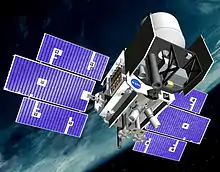
The Combined Release and Radiation Effects Satellite (CRRES) was launched in 1990 on a three year mission to investigate fields, plasmas, and energetic particles inside the Earth's magnetosphere.[157] The Upper Atmosphere Research Satellite (UARS) was launched in 1991 by STS-48 to study the Earth's atmosphere especially the protective ozone layer.[158] TOPEX/Poseidon was launched in 1992 and was the first significant oceanographic research satellite.[159]
The Ice, Cloud, and land Elevation Satellite (ICESat) was launched in 2003, operated for 7 years, and measured ice sheet mass balance, cloud and aerosol heights, and well as topography and vegetation characteristics.[160]
Over a dozen past robotic missions have focused on the study of the Earth and its environment. Some of these additional spacecraft include: Aquarius, Earth Observing-1 (EO-1), Jason-1, Ocean Surface Topography Mission/Jason-2, and Radarsat-1 missions.
Active programs
International Space Station (1993–present)

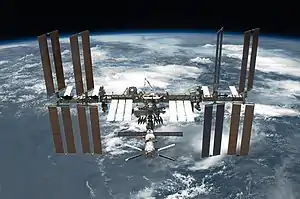
The International Space Station (ISS) combines NASA's Space Station Freedom project with the Soviet/Russian Mir-2 station, the European Columbus station, and the Japanese Kibō laboratory module.[161] NASA originally planned in the 1980s to develop Freedom alone, but US budget constraints led to the merger of these projects into a single multi-national program in 1993, managed by NASA, the Russian Federal Space Agency (RKA), the Japan Aerospace Exploration Agency (JAXA), the European Space Agency (ESA), and the Canadian Space Agency (CSA).[162][163] The station consists of pressurized modules, external trusses, solar arrays and other components, which were manufactured in various factories around the world, and have been launched by Russian Proton and Soyuz rockets, and the US Space Shuttles.[161] The on-orbit assembly began in 1998, the completion of the US Orbital Segment occurred in 2009 and the completion of the Russian Orbital Segment occurred in 2010, though there are some debates of whether new modules should be added in the segment. The ownership and use of the space station is established in intergovernmental treaties and agreements[164] which divide the station into two areas and allow Russia to retain full ownership of the Russian Orbital Segment (with the exception of Zarya),[165][166] with the US Orbital Segment allocated between the other international partners.[164]
Long-duration missions to the ISS are referred to as ISS Expeditions. Expedition crew members typically spend approximately six months on the ISS.[167] The initial expedition crew size was three, temporarily decreased to two following the Columbia disaster. Since May 2009, expedition crew size has been six crew members.[168] Crew size is expected to be increased to seven, the number the ISS was designed for, once the Commercial Crew Program becomes operational.[169] The ISS has been continuously occupied for the past 21 years and 357 days, having exceeded the previous record held by Mir; and has been visited by astronauts and cosmonauts from 15 different nations.[170][171]
The station can be seen from the Earth with the naked eye and, as of 2022, is the largest artificial satellite in Earth orbit with a mass and volume greater than that of any previous space station.[172] The Russian Soyuz and American Dragon spacecraft are used to send astronauts to and from the ISS. Several uncrewed cargo spacecraft provide service to the ISS; they are the Russian Progress spacecraft which has done so since 2000, the European Automated Transfer Vehicle (ATV) since 2008, the Japanese H-II Transfer Vehicle (HTV) since 2009, the (uncrewed) Dragon since 2012, and the American Cygnus spacecraft since 2013.[173][174] The Space Shuttle, before its retirement, was also used for cargo transfer and would often switch out expedition crew members, although it did not have the capability to remain docked for the duration of their stay. Between the retirement of the Shuttle in 2011 and the commencement of crewed Dragon flights in 2020, American astronauts exclusively used the Soyuz for crew transport to and from the ISS[175] The highest number of people occupying the ISS has been thirteen; this occurred three times during the late Shuttle ISS assembly missions.[176]
The ISS program is expected to continue to 2030,[177] after which the space station will be retired and destroyed in a controlled de-orbit.[178]
Commercial Resupply Services (2008–present)
Commercial Resupply Services (CRS) are a contract solution to deliver cargo and supplies to the International Space Station (ISS) on a commmercial basis.[179] NASA signed its first CRS contracts in 2008 and awarded $1.6 billion to SpaceX for twelve cargo Dragon and $1.9 billion to Orbital Sciences[note 3] for eight Cygnus flights, covering deliveries to 2016. Both companies evolved or created their launch vehicle products to support the solution (SpaceX with The Falcon 9 and Orbital with the Antares).
SpaceX flew its first operational resupply mission (SpaceX CRS-1) in 2012.[180] Orbital Sciences followed in 2014 (Cygnus CRS Orb-1).[181] In 2015, NASA extended CRS-1 to twenty flights for SpaceX and twelve flights for Orbital ATK.[note 3][182][183]
A second phase of contracts (known as CRS-2) was solicited in 2014; contracts were awarded in January 2016 to Orbital ATK[note 3] Cygnus, Sierra Nevada Corporation Dream Chaser, and SpaceX Dragon 2, for cargo transport flights beginning in 2019 and expected to last through 2024. In March 2022, NASA awarded an additional six CRS-2 missions each to both SpaceX and Northrop Grumman (formerly Orbital).[184]
Northrop Grumman successfully delivered Cygnus NG-17 to the ISS in February 2022.[185] In July 2022, SpaceX launched its 25th CRS flight (SpaceX CRS-25) and successfully delivered its cargo to the ISS.[186] In late 2022, Sierra Nevada continued to assemble their Dream Chaser CRS solution; current estimates put its first launch in early 2023.[187]
Commercial Crew Program (2011–present)
.svg.png.webp)
The Commercial Crew Program (CCP) provides commercially operated crew transportation service to and from the International Space Station (ISS) under contract to NASA, conducting crew rotations between the expeditions of the International Space Station program. American space manufacturer SpaceX began providing service in 2020, using the Crew Dragon spacecraft, and NASA plans to add Boeing when its Boeing Starliner spacecraft becomes operational some time after 2022.[188] NASA has contracted for six operational missions from Boeing and fourteen from SpaceX, ensuring sufficient support for ISS through 2030.[189]
The spacecraft are owned and operated by the vendor, and crew transportation is provided to NASA as a commercial service. Each mission sends up to four astronauts to the ISS, with an option for a fifth passenger available. Operational flights occur approximately once every six months for missions that last for approximately six months. A spacecraft remains docked to the ISS during its mission, and missions usually overlap by at least a few days. Between the retirement of the Space Shuttle in 2011 and the first operational CCP mission in 2020, NASA relied on the Soyuz program to transport its astronauts to the ISS.
A Crew Dragon spacecraft is launched to space atop a Falcon 9 Block 5 launch vehicle and the capsule returns to Earth via splashdown in the ocean near Florida. The program's first operational mission, SpaceX Crew-1, launched on 16 November 2020.[190] Boeing Starliner operational flights will now commence after its final test flight which was launched atop an Atlas V N22 launch vehicle. Instead of a splashdown, a Starliner capsule returns on land with airbags at one of four designated sites in the western United States.[191]
Artemis (2017–present)
.svg.png.webp)
.jpg.webp)
Since 2017, NASA's crewed spaceflight program has been the Artemis program, which involves the help of US commercial spaceflight companies and international partners such as ESA, JAXA, and CSA.[192] The goal of this program is to land "the first woman and the next man" on the lunar south pole region by 2024. Artemis would be the first step towards the long-term goal of establishing a sustainable presence on the Moon, laying the foundation for companies to build a lunar economy, and eventually sending humans to Mars.
The Orion Crew Exploration Vehicle was held over from the canceled Constellation program for Artemis. Artemis 1 is the uncrewed initial launch of Space Launch System (SLS) that would also send an Orion spacecraft on a Distant Retrograde Orbit.[193]
NASA's next major space initiative is to be the construction of the Lunar Gateway, a small space station in lunar orbit.[194] This space station will be designed primarily for non-continuous human habitation. The first tentative steps of returning to crewed lunar missions will be Artemis 2, which is to include the Orion crew module, propelled by the SLS, and is to launch in 2024.[192] This mission is to be a 10-day mission planned to briefly place a crew of four into a Lunar flyby.[133] The construction of the Gateway would begin with the proposed Artemis 3, which is planned to deliver a crew of four to Lunar orbit along with the first modules of the Gateway. This mission would last for up to 30 days. NASA plans to build full scale deep space habitats such as the Lunar Gateway and the Nautilus-X as part of its Next Space Technologies for Exploration Partnerships (NextSTEP) program.[195] In 2017, NASA was directed by the congressional NASA Transition Authorization Act of 2017 to get humans to Mars-orbit (or to the Martian surface) by the 2030s.[196][197]
In support of the Artemis missions, NASA has been funding private companies to land robotic probes on the lunar surface in a program known as the Commercial Lunar Payload Services. As of March 2022, NASA has awarded contracts for robotic lunar probes to companies such as Intuitive Machines, Firefly Space Systems, and Astrobotic.[198]
On April 16, 2021, NASA announced they had selected the SpaceX Lunar Starship as its Human Landing System. The agency's Space Launch System rocket will launch four astronauts aboard the Orion spacecraft for their multi-day journey to lunar orbit where they will transfer to SpaceX's Starship for the final leg of their journey to the surface of the Moon.[199]
In November 2021, it was announced that the goal of landing astronauts on the Moon by 2024 had slipped to no earlier than 2025 due to numerous factors. As of June 2022, NASA plans to launch Artemis 1 no earlier than August 2022, Artemis 2 in May 2024 and Artemis 3 sometime in 2025.[200][201] Additional Artemis missions, Artemis 4 and Artemis 5, are planned to launch after 2025.[202]
Commercial LEO Development (2021–present)
The Commercial Low Earth Orbit Destinations program is an initiative by NASA to support work on commercial space stations that the agency hopes to have in place by the end of the current decade to replace the "International Space Station". The three selected companies are: Blue Origin (et al.) with their Orbital Reef station concept, Nanoracks (et al.) with their Starlab Space Station concept, and Northrop Grumman with a station concept based on the HALO-module for the Gateway station.[203]
Robotic exploration
NASA has conducted many uncrewed and robotic spaceflight programs throughout its history. More than 1,000 uncrewed missions have been designed to explore the Earth and the Solar System.[135]
Mission Selection Process
NASA executes a mission development framework to plan, select, develop, and operate robotic missions. This framework defines cost, schedule and technical risk parameters to enable competitive selection of missions involving mission candidates that have been developed by principal investigators and their teams from across NASA, the broader U.S. Government research and development stakeholders, and industry. The mission development construct is defined by four umbrella programs.
Explorer program
The Explorer program derives its origin from the earliest days of the U.S. Space program. In current form, the program consists of three classes of systems - Small Explorers (SMEX), Medium Explorers (MIDEX), and University-Class Explorers (UNEX) missions. The NASA Explorer program office provides frequent flight opportunities for moderate cost innovative solutions from the heliophysics and astrophysics science areas. The Small Explorer missions are required to limit cost to NASA to below $150M (2022 dollars). Medium class explorer missions have typically involved NASA cost caps of $350M. The Explorer program office is based at NASA Goddard Space Flight Center.[204]
Discovery program
The NASA Discovery program develops and delivers robotic spacecraft solutions in the planetary science domain. Discovery enables scientists and engineers to assemble a team to deliver a solution against a defined set of objectives and competitively bid that solution against other candidate programs. Cost caps vary but recent mission selection processes were accomplished using a $500M cost cap to NASA. The Planetary Mission Program Office is based at the NASA Marshall Space Flight Center and manages both the Discovery and New Frontiers missions. The office is part of the Science Mission Directorate.[205]
NASA Administrator Bill Nelson announced on June 2, 2021 that the DAVINCI+ and VERITAS missions were selected to launch to Venus in the late 2020s, having beat out competing proposals for missions to Jupiter’s volcanic moon Io and Neptune’s large moon Triton that were also selected as Discovery program finalists in early 2020. Each mission has an estimated cost of $500 million, with launches expected between 2028 and 2030. Launch contracts will be awarded later in each mission’s development.[206]
New Frontiers program
The New Frontiers program tackles specific solar system exploration goals identified as top priorities by the planetary science community. Primary objectives include solar system exploration employing medium class spacecraft missions to conduct high-science-return investigations. New Frontiers builds on the development approach employed by the Discovery program but provides for higher cost caps and schedule durations than are available with Discovery. Cost caps vary by opportunity; recent missions have been awarded based on a defined cap of $1 Billion. The higher cost cap and projected longer mission durations result in a lower frequency of new opportunities for the program - typically one every several years. OSIRIS-REx and New Horizons are examples of New Frontiers missions.[207]
NASA has determined that the next opportunity to propose for the fifth round of New Frontiers missions will occur no later than the fall of 2024. Missions in NASA’s New Frontiers Program tackle specific solar system exploration goals identified as top priorities by the planetary science community. The strategy is to explore the solar system with medium-class spacecraft missions that conduct high-science-return investigations that add to our understanding of the solar system.[208]
Large Strategic Missions
Large Strategic Missions (formerly called Flagship missions) are strategic missions that are typically developed and managed by large teams that may span several NASA centers. The indiivdual missions become the program as opposed to being part of a larger effort (see Discovery, New Frontiers, etc). The James Webb Space Telescope is a strategic mission that was developed over a period of more than 20 years. Strategic missions are developed on an ad-hoc basis as program objectives and priorities are established. Missions like Voyager, had they been developed today, would have been strategic missions. Three of the Great Observatories were strategic missions (Chandra, Compton, Hubble). Europa Clipper is the next large strategic mission in development by NASA.
Planetary Science Missions
NASA continues to play a material in exploration of the solar system as it has for decades. Ongoing missions have current science objectives with respect to more than five extraterrestrial bodies within the solar system – Moon (Lunar Reconnaissance Orbiter), Mars (Perseverance), Jupiter (Juno), asteroid Bennu (OSIRIS-REx), and Kuiper Belt Objects (New Horizons). The Juno extended mission will make multiple flybys of the Jovian moon Io in 2023 and 2024 after flybys of Ganymede in 2021 and Europa in 2022. Voyager 1 and Voyager 2 continue to provide science data back to Earth while continuing on their outward journeys into interstellar space.
On November 26, 2011, NASA's Mars Science Laboratory mission was successfully launched for Mars. Curiosity successfully landed on Mars on August 6, 2012, and subsequently began its search for evidence of past or present life on Mars.[209][210][211]
In September 2014, NASA's MAVEN spacecraft, which is part of the Mars Scout Program, successfully entered Mars orbit and, as of October 2022, continues its study of the atmosphere of Mars.[212][213] NASA's ongoing Mars investigations include in-depth surveys of Mars (Perseverance and InSight).
NASA has authorized the Europa Clipper orbiter mission that is planned to launch in October 2024 and will study the Galilean moon Europa through a series of flybys while in orbit around Jupiter. Dragonfly will send a mobile robotic rotorcraft to Saturn's biggest moon Titan[214] As of May 2021, Dragonfly is scheduled for launch in June 2027.[215][216]
Astrophysics Missions
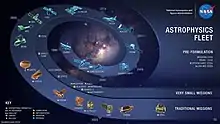
The NASA Science Mission Directorate Astrophysics division manages the agency's astrophysics science portfolio. NASA has invested significant resources in the development, delivery, and operations of various forms of space telescopes. These telescopes have provided the means to study the cosmos over a large range of the electromagnetic spectrum.[217]
The Great Observatories that were launched in the 1980s and 1990s have provided a wealth of observations for study by physicists across the planent. The first of them, the Hubble Space Telescope, was delivered to orbit in 1990 and continues to function today, in part due to prior servicing missions performed by the Space Shuttle.[218][219] The other remaining active great observatory, the Chandra X-ray Observatory (CXO) was launched by STS-93 in July 1999, operates in a 64-hour period elliptical orbit, and is improving the study of X-ray sources that are not readily viewable from terrestrial observatories.[220]
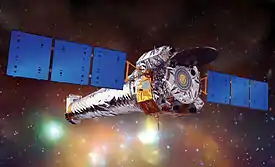
The Imaging X-ray Polarimetry Explorer (IXPE) is a space observatory designed to improve our understanding of X-ray production in objects such as neutron stars and pulsar wind nebulae, as well as stellar and supermassive black holes.[221] IXPE launched in December 2021 and is an international collaboration between NASA and the Italian Space Agency (ASI). It is part of the NASA Small Explorers program (SMEX) which designs low-cost spacecraft to study heliophysics and astrophysics.[222]
The Neil Gehrels Swift Observatory was launched in November 2004 and is Gamma-ray burst observatory that also monitors the afterglow in X-ray, and UV/Visible light at the location of a burst.[223] The mission was developed in a joint partnership between Goddard Space Flight Center (GSFC) and an international consortium from the United States, United Kingdom, and Italy. Pennsylvania State University operates the mission as part of NASA's Medium Explorer program (MIDEX).[224]
The Fermi Gamma-ray Space Telescope (FGST) is another gamma-ray focused space observatory that was launched to low Earth orbit in June 2008 and is being used to perform gamma-ray astronomy observations.[225] In addition to NASA, the mission involves the United States Department of Energy, and government agencies in France, Germany, Italy, Japan, and Sweden.[226]
The James Webb Space Telescope (JWST), launched in December 2021 on an Ariane 5 rocket, operates in a halo orbit circling the Sun-Earth L2 point. [227][228][229] JWST's high sensitivity in the infrared spectrum and its imaging resolution will allow it to view more distant, faint, or older objects than its predecessors, including Hubble.[230]
Earth Sciences Program Missions (1965–present)
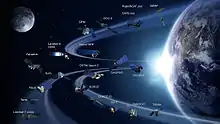
NASA Earth Science is a large, umbrella program comprising a range of terrestrial and space-based collection systems in order to better understand the Earth system and its response to natural and human-caused changes. Numerous systems have been developed and fielded over several decades to provide improved prediction for weather, climate, and other changes in the natural environment. Several of the current operating spacecraft programs include: Aqua,[231] Aura,[232] Orbiting Carbon Observatory 2 (OCO-2),[233] Gravity Recovery and Climate Experiment Follow-on (GRACE FO),[234] and Ice, Cloud, and land Elevation Satellite 2 (ICESat-2).[235]
In addition to systems already in orbit, NASA is designing a new set of Earth Observing Systems to study, assess, and generate responses for climate change, natural hazards, forest fires, and real-time agricultural processes.[236] The GOES-T satellite (designated GOES-18 after launch) joined the fleet of U.S. geostationary weather monitoring satellites in March 2022.[237]
NASA also maintains the Earth Science Data Systems (ESDS) program to oversee the life cycle of NASA’s Earth science data — from acquisition through processing and distribution. The primary goal of ESDS is to maximize the scientific return from NASA's missions and experiments for research and applied scientists, decision makers, and society at large.[238]
The Earth Science program is managed by the Earth Science Division of the NASA Science Mission Directorate.
Space operations architecture
NASA invests in various ground and space based infrastructures to support its science and exploration mandate. The agency maintains access to suborbital and orbital space launch capabilities and sustains ground station solutions to support its evolving fleet of spacecraft and remote systems.
Deep Space Network (1963–present)
The NASA Deep Space Network (DSN) serves as the primary ground station solution for NASA's interplanetary spacecraft and select Earth-orbiting missions.[239] The system employs ground station complexes near Barstow California in the United States, in Spain near Madrid, and in Australia near Canberra. The placement of these ground stations approximately 120 degrees apart around the planet provides the ability for communications to spacecraft throughout the Solar System even as the earth rotates about its axis on a daily basis. The system is controlled at a 24x7 operations center at JPL in Pasadena California which manages recurring communications linkages with up to 40 spacecraft.[240] The system is managed by the Jet Propulsion Laboratory (JPL).[239]
Near Space Network (1983–present)
_2021.png.webp)
The Near Space Network (NSN) provides telemetry, commanding, ground-based tracking, data and communications services to a wide range of customers with satellites in low earth orbit (LEO, geosynchronous orbit (GEO), highly elliptical orbits (HEO), and lunar orbits. The NSN accumulates ground station and antenna assets from the Near Earth Network and the Tracking and Data Relay Satellite System (TDRS) which operates in geosynchronous orbit providing continuous real-time coverage for launch vehicles and low earth orbit NASA missions.[241]
The NSN consists of 19 ground stations worldwide operated by the US Government and by contractors including Kongsberg Satellite Services (KSAT), Swedish Space Corporation (SSC), and South African National Space Agency (SANSA).[242] The ground network averages between 120 and 150 spacecraft contacts a day with TDRS engaging with systems on a near-continuous basis as needed; the system is managed and operated by the Goddard Space Flight Center.[243]
Sounding Rocket Program (1959–present)
.jpg.webp)
The NASA Sounding Rocket Program (NSRP) is located at the Wallops Flight Facility and provides launch capability, payload development and integration, and field operations support to execute suborbital missions.[244] The program has been in operation since 1959 and is managed by the Goddard Space Flight Center using a combined US Government and contractor team.[245] The NSRP team conducts approximately 20 missions per year from both Wallops and other launch locations worldwide to allow scientists to collect data "where it occurs". The program supports the strategic vision of the Science Mission Directorate collecting important scientific data for earth science, heliophysics, and astrophysics programs.[244]
In June 2022, NASA conducted its first rocket launch from a commmercial spaceport outside the US. It launched a Black Brant IX from the Arnhem Space Centre in Australia.[246]
Launch Services Program (1990–present)

The NASA Launch Services Program (LSP) is responsible for procurement of launch services for NASA uncrewed missions and oversight of launch integration and launch preparation activity, providing added quality and mission assurance to meet program objectives.[247] Since 1990, NASA has purchased expendable launch vehicle launch services directly from commercial providers, whenever possible, for its scientific and applications missions. Expendable launch vehicles can accommodate all types of orbit inclinations and altitudes and are ideal vehicles for launching Earth-orbit and interplanetary missions. LSP operates from Kennedy Space Center and falls under the NASA Space Operations Mission Directorate (SOMD).[248][249]
Aeronautics Research
The Aeronautics Research Mission Directorate (ARMD) is one of five mission directorates within NASA, the other four being the Exploration Systems Development Mission Directorate, the Space Operations Mission Directorate, the Science Mission Directorate, and the Space Technology Mission Directorate.[250] The ARMD is responsible for NASA's aeronautical research, which benefits the commercial, military, and general aviation sectors. ARMD performs its aeronautics research at four NASA facilities: Ames Research Center and Armstrong Flight Research Center in California, Glenn Research Center in Ohio, and Langley Research Center in Virginia.[251]
NASA X-57 Maxwell aircraft (2016–present)
The NASA X-57 Maxwell is an experimental aircraft being developed by NASA to demonstrate the technologies required to deliver a highly-efficient all-electric aircraft.[252] The primary goal of the program is to develop and deliver all-electric technology solutions that can also achieve airworthiness certification with regulators. The program involves development of the system in several phases, or modifications, to incrementally grow the capability and operability of the system. The initial configuration of the aircraft has now completed ground testing as it approaches its first flights. In mid-2022, the X-57 was scheduled to fly before the end of the year.[253] The development team includes staff from the NASA Armstrong, Glenn, and Langley centers along with number of industry partners from the United States and Italy.[254]
Next Generation Air Transportation System (2007–present)
NASA is collaborating with the Federal Aviation Adminstration and industry stakeholders to modernize the United States National Airspace System (NAS). Efforts begain in 2007 with a goal to deliver major modernization components by 2025.[255] The modernization effort intends to increase the safety, efficiency, capacity, access, flexibility, predictability, and resilience of the NAS while reducing the environmental impact of aviation.[256] The Aviation Systems Division of NASA Ames operates the joint NASA/FAA North Texas Research Station. The station supports all phases of NextGen research, from concept development to prototype system field evaluation. This facility has already transitioned advanced NextGen concepts and technologies to use through technology transfers to the FAA.[255] NASA contributions also include development of advanced automation concepts and tools that provide air traffic controllers, pilots, and other airspace users with more accurate real-time information about the nation's traffic flow, weather, and routing.Ames' advanced airspace modeling and simulation tools have been used extensively to model the flow of air traffic flow across the U.S., and to evaluate new concepts in airspace design, traffic flow management, and optimization.[257]
Nuclear in-space power and propulsion (ongoing)
NASA has made use of technologies such as the multi-mission radioisotope thermoelectric generator (MMRTG), which is a type of radioisotope thermoelectric generator used to power spacecraft.[258] Shortages of the required plutonium-238 have curtailed deep space missions since the turn of the millennium.[259] An example of a spacecraft that was not developed because of a shortage of this material was New Horizons 2.[259]
In July 2021, NASA announced contract awards for development of nuclear thermal propulsion reactors. Three contractors will develop individual designs over 12 months for later evaluation by NASA and the U.S. Department of Energy.[260] NASA's space nuclear technologies portfolio are led and funded by its Space Technology Mission Directorate.
Other Initiatives
Free Space Optics. NASA contracted a third party to study the probability of using Free Space Optics (FSO) to communicate with Optical (laser) Stations on the Ground (OGS) called laser-com RF networks for satellite communications.[261]
Water Extraction from Lunar Soil. On July 29, 2020, NASA requested American universities to propose new technologies for extracting water from the lunar soil and developing power systems. The idea will help the space agency conduct sustainable exploration of the Moon.[262]
Human Spaceflight Research (2005–present)
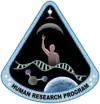
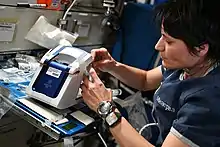
NASA's Human Research Program (HRP) is designed to study the effects of space on human health and also to provide countermeasures and technologies for human space exploration. The medical effects of space exploration are reasonably limited in Low Earth Orbit or in travel to the Moon. Travel to Mars, however is significantly longer and deeper into space and significant medical issues can result. This includes bone loss, radiation exposure, vision changes, circadian rhythm disturbances, heart remodeling, and immune alterations. In order to study and diagnose these ill-effects, HRP has been tasked with identifying or developing small portable instrumentation with low mass, volume, and power to monitor the health of astronauts.[263] To achieve this aim, on May 13, 2022, NASA and SpaceX Crew-4 astronauts successfully tested its rHEALTH ONE universal biomedical analyzer for its ability to identify and analyzer biomarkers, cells, microorganisms, and proteins in a spaceflight environment.[264]
Planetary Defense (2016–present)

NASA established the Planetary Defense Coordination Office (PDCO) in 2016 to catalog and track potentially hazardous near-Earth objects (NEO), such as asteroids and comets and develop potential responses and defenses against these threats.[265] The PDCO is chartered to provide timely and accurate information to the government and the public on close approaches by Potentially hazardous objects (PHOs) and any potential for impact. The office functions within the Science Mission Directorate Planetary Science division.[266]
The PDCO augmented prior cooperative actions between the United States, the European Union, and other nations which had been scanning the sky for NEOs since 1998 in an effort called Spaceguard.[267]
Near Earth Object Detection (1998–present)
From the 1990s NASA has run many NEO detection programs from Earth bases observatories, greatly increasing the number of objects that have been detected. However, many asteroids are very dark and the ones that are near the Sun are much harder to detect from Earth-based telescopes which observe at night, and thus face away from the Sun. NEOs inside Earth orbit only reflect a part of light also rather than potentially a "full Moon" when they are behind the Earth and fully lit by the Sun.
In 1998, the United States Congress gave NASA a mandate to detect 90% of near-earth asteroids over 1 km (0.62 mi) diameter (that threaten global devastation) by 2008.[268] This initial mandate was met by 2011.[269] In 2005, the original USA Spaceguard mandate was extended by the George E. Brown, Jr. Near-Earth Object Survey Act, which calls for NASA to detect 90% of NEOs with diameters of 140 m (460 ft) or greater, by 2020 (compare to the 20-meter Chelyabinsk meteor that hit Russia in 2013).[270] As of January 2020, it is estimated that less than half of these have been found, but objects of this size hit the earth only about once in 2,000 years.[271]
In January 2020, NASA officials estimated it would take 30 years to find all objects meeting the 140 m (460 ft) size criteria, more than twice the timeframe that was built into the 2005 mandate.[272] In June 2021, NASA authorized the development of the NEO Surveyor spacecraft to reduce that projected duration to achieve the mandate down to 10 years.[273][274]
Involvement in current robotic missions
NASA has incorporated planetary defense objectives into several ongoing missions.
In 1999, NASA visited 433 Eros with the NEAR Shoemaker spacecraft which entered its orbit in 2000, closely imaging the asteroid with various instruments at that time.[275] NEAR Shoemaker became the first spacecraft to successfully orbit and land on an asteroid, improving our understanding of these bodies and demonstrating our capacity to study them in greater detail.[276]
OSIRIS-REx used its suite of instruments to transmit radio tracking signals and capture optical images of Bennu during its study of the asteroid that will help NASA scientists determine its precise position in the solar system and its exact orbital path. As Bennu has the potential for recurring approaches to the Earth-Moon system in the next 100-200 years, the precision gained from OSIRIS-REx will enable scientists to better predict the future gravitational interactions between Bennu and our planet and resultant changes in Bennu's onward flight path.[277][278]
The WISE/NEOWISE mission was launched by NASA JPL in 2009 as an infrared-wavelength astronomical space telescope. In 2013, NASA repurposed it as the NEOWISE mission to find potentially hazardous near-Earth asteroids and comets; its mission has been extended into 2023.[279][280]
NASA and Johns Hopkins Applied Physics Laboratory (JHAPL) jointly developed the first planetary defense purpose-built satellite, the Double Asteroid Redirection Test (DART) to test possible planetary defense concepts.[281] DART was launched in November 2021 by a SpaceX Falcon 9 from California on a trajectory designed to impact the Dimorphos asteriod. Scientists were seeking to determine whether an impact could alter the subsequent path of the asteroid; a concept that could be applied to future planetary defense.[282] On September 26, 2022, DART hit its target. Studies in the weeks following impact will determine the extent that the impact changed the trajectory of the NEO.[283]
NEO Surveyor, formerly called the Near-Earth Object Camera (NEOCam) mission, is a space-based infrared telescope under development to survey the Solar System for potentially hazardous asteroids.[284] The spacecraft is scheduled to launch in 2026.
Study of Unidentified Aerial Phenomena (2022–present)
In June 2022, the head of the NASA Science Mission Directorate, Thomas Zurbuchen, confirmed that NASA would join the hunt for Unidentified Flying Objects (UFOs)/Unidentified Aerial Phenomena (UAPs).[285] At a speech before the National Academies of Science, Engineering and Medicine, Zurbuchen said the space agency would bring a scientific perspective to efforts already underway by the Pentagon and intelligence agencies to make sense of dozens of such sightings. He said it was “high-risk, high-impact” research that the space agency should not shy away from, even if it is a controversial field of study.[286]
Collaboration
NASA Advisory Council
In response to the Apollo 1 accident, which killed three astronauts in 1967, Congress directed NASA to form an Aerospace Safety Advisory Panel (ASAP) to advise the NASA Administrator on safety issues and hazards in NASA's air and space programs. In the aftermath of the Shuttle Columbia disaster, Congress required that the ASAP submit an annual report to the NASA Administrator and to Congress.[287] By 1971, NASA had also established the Space Program Advisory Council and the Research and Technology Advisory Council to provide the administrator with advisory committee support. In 1977, the latter two were combined to form the NASA Advisory Council (NAC).[288] The NASA Authorization Act of 2014 reaffirmed the importance of ASAP.
Partnership with the United States Space Force

The United States Space Force (USSF) is the space service branch of the United States Armed Forces, while the National Aeronautics and Space Administration (NASA) is an independent agency of the United States government responsible for civil spaceflight. NASA and the Space Force's predecessors in the Air Force have a long-standing cooperative relationship, with the Space Force supporting NASA launches out of Kennedy Space Center, Cape Canaveral Space Force Station, and Vandenberg Space Force Base, to include range support and rescue operations from Task Force 45.[289] NASA and the Space Force also partner on matters such as defending Earth from asteroids.[290] Space Force members can be NASA astronauts, with Colonel Michael S. Hopkins, the commander of SpaceX Crew-1, commissioned into the Space Force from the International Space Station on December 18, 2020.[291][292][293] In September 2020, the Space Force and NASA signed a memorandum of understanding formally acknowledging the joint role of both agencies. This new memorandum replaced a similar document signed in 2006 between NASA and Air Force Space Command.[294][295]
Collaboration with the U.S. Geological Survey
The Landsat program is the longest-running enterprise for acquisition of satellite imagery of Earth. It is a joint NASA / USGS program.[296] On July 23, 1972, the Earth Resources Technology Satellite was launched. This was eventually renamed to Landsat 1 in 1975.[297] The most recent satellite in the series, Landsat 9, was launched on September 27, 2021.[298]
The instruments on the Landsat satellites have acquired millions of images. The images, archived in the United States and at Landsat receiving stations around the world, are a unique resource for global change research and applications in agriculture, cartography, geology, forestry, regional planning, surveillance and education, and can be viewed through the U.S. Geological Survey (USGS) "EarthExplorer" website. The collaboration between NASA and USGS involves NASA designing and delivering the space system (satellite) solution, launching the satellite into orbit with the USGS operating the system once in orbit.[296] As of October 2022, nine satellites have been built with eight of them successfully operating in orbit.
Cooperation with JAXA

NASA and the Japan Aerospace Exploration Agency (JAXA) cooperate on a range of space projects. JAXA is a direct participant in the Artemis program, including the Lunar Gateway effort. JAXA's planned contributions to Gateway include I-Hab’s environmental control and life support system, batteries, thermal control, and imagery components, which will be integrated into the module by the European Space Agency (ESA) prior to launch. These capabilities are critical for sustained Gateway operations during crewed and uncrewed time periods.[299][300]
JAXA and NASA have collaborated on numerous satellite programs, especially in areas of earth science. NASA has contributed to JAXA satellites and vice versa. Japanese instruments are flying on NASA's Terra and Aqua satellites, and NASA sensors have flown on previous Japanese Earth-observation missions. The NASA-JAXA Global Precipitation Measurement mission was launched in 2014 and includes both NASA- and JAXA-supplied sensors on a NASA satellite launched on a JAXA rocket. The mission provides the frequent, accurate measurements of rainfall over the entire globe for use by scientists and weather forecasters.[301]
Cooperation with the Indian Space Research Organisation

In September 2014, NASA and Indian Space Research Organisation (ISRO) signed a partnership to collaborate on and launch a joint radar mission, the NASA-ISO Synthetic Aperature Radar (NISAR) mission. The mission is targeted to launch in 2024. NASA will provide the mission’s L-band synthetic aperture radar, a high-rate communication subsystem for science data, GPS receivers, a solid-state recorder and payload data subsystem. ISRO provides the spacecraft bus, the S-band radar, the launch vehicle and associated launch services.[302][303]
Artemis Accords
The Artemis Accords have been established to define a framework for cooperating in the peaceful exploration and exploitation of the Moon, Mars, asteroids, and comets. The Accords were drafted by NASA and the U.S. State Department and are executed as a series of bilateral agreements between the United States and the participating countries.[304][305] As of September 2022, 21 countries have signed the accords. They are: Australia, Bahrain, Brazil, Canada, Colombia, France, Israel, Italy, Japan, the Republic of Korea, Luxembourg, Mexico, New Zealand, Poland, Romania, the Kingdom of Saudi Arabia, Singapore, Ukraine, the United Arab Emirates, the United Kingdom, and the United States.[306][307]
Related agencies
- European Space Agency – European organisation dedicated to space exploration (ESA)
- Roscosmos – Space agency of Russia
- China National Space Administration – National space agency of the People's Republic of China (CNSA)
Sustainability
Environmental impact
The exhaust gases produced by rocket propulsion systems, both in Earth's atmosphere and in space, can adversely effect the Earth's environment. Some hypergolic rocket propellants, such as hydrazine, are highly toxic prior to combustion, but decompose into less toxic compounds after burning. Rockets using hydrocarbon fuels, such as kerosene, release carbon dioxide and soot in their exhaust.[308] However, carbon dioxide emissions are insignificant compared to those from other sources; on average, the United States consumed 803 million US gal (3.0 million m3) of liquid fuels per day in 2014, while a single Falcon 9 rocket first stage burns around 25,000 US gallons (95 m3) of kerosene fuel per launch.[309][310] Even if a Falcon 9 were launched every single day, it would only represent 0.006% of liquid fuel consumption (and carbon dioxide emissions) for that day. Additionally, the exhaust from LOx- and LH2- fueled engines, like the SSME, is almost entirely water vapor.[311] NASA addressed environmental concerns with its canceled Constellation program in accordance with the National Environmental Policy Act in 2011.[312] In contrast, ion engines use harmless noble gases like xenon for propulsion.[313][314]
An example of NASA's environmental efforts is the NASA Sustainability Base. Additionally, the Exploration Sciences Building was awarded the LEED Gold rating in 2010.[315] On May 8, 2003, the Environmental Protection Agency recognized NASA as the first federal agency to directly use landfill gas to produce energy at one of its facilities—the Goddard Space Flight Center, Greenbelt, Maryland.[316]
In 2018, NASA along with other companies including Sensor Coating Systems, Pratt & Whitney, Monitor Coating and UTRC launched the project CAUTION (CoAtings for Ultra High Temperature detectION). This project aims to enhance the temperature range of the Thermal History Coating up to 1,500 °C (2,730 °F) and beyond. The final goal of this project is improving the safety of jet engines as well as increasing efficiency and reducing CO2 emissions.[317]
Climate change
NASA also researches and publishes on climate change.[318] Its statements concur with the global scientific consensus that the global climate is warming.[319] Bob Walker, who has advised US President Donald Trump on space issues, has advocated that NASA should focus on space exploration and that its climate study operations should be transferred to other agencies such as NOAA. Former NASA atmospheric scientist J. Marshall Shepherd countered that Earth science study was built into NASA's mission at its creation in the 1958 National Aeronautics and Space Act.[320] NASA won the 2020 Webby People's Voice Award for Green in the category Web.[321]
STEM Initiatives
Educational Launch of Nanosatellites (ELaNa). Since 2011, the ELaNa program has provided opportunities for NASA to work with university teams to test emerging technologies and commercial-off-the-shelf solutions by providing launch opportunities for developed CubeSats using NASA procured launch opportunities.[322] By example, two NASA-sponsored CubeSats launched in June 2022 on a Virgin Orbit LauncherOne vehicle as the ELaNa 39 mission.[323]
Cubes in Space. NASA started an annual competition in 2014 named Cubes in Space.[324] It is jointly organized by NASA and the global education company I Doodle Learning, with the objective of teaching school students aged 11–18 to design and build scientific experiments to be launched into space on a NASA rocket or balloon. On June 21, 2017, the world's smallest satellite, KalamSAT, was launched.[325]
Use of the metric system
US law requires the International System of Units to be used in all US Government programs, "except where impractical".[326]
In 1969, the Apollo 11 landed on the Moon using a mix of United States customary units and metric units. In the 1980s, NASA started the transition towards the metric system, but was still using both systems in the 1990s.[327][328] On September 23, 1999, a unit mixup between US and SI units resulted in the loss of the Mars Climate Orbiter.[329]
In August 2007, NASA stated that all future missions and explorations of the Moon would be done entirely using the SI system. This was done to improve cooperation with space agencies of other countries that already use the metric system.[330]
As of 2007, NASA is predominantly working with SI units, but some projects still use English units, and some, including the International Space Station, use a mix of both.[331]
Media Presence
NASA TV
Approaching 40 years of service, the NASA TV channel airs content ranging from live coverage of manned missions to video coverage of significant milestones for operating robotic spacecraft (e.g. rover landings on Mars for example) and domestic and international launches.[332] The channel is delivered by NASA and is broadcast by satellite and over the internet. The system initially started to capture archival footage of important space events for NASA managers and engineers and expanded as public interest grew. The Apollo 8 Christmas eve broadcast while in orbit around the Moon was received by more than a billion people.[333] NASA's video transmission of the Apollo 11 moon landing was awarded a primetime emmy in commemoration of the 40th anniversary of the landing.[334] The channel is a product of the U.S. Government and is widely available across many television and internet platforms.[335]
NASAcast
NASAcast is the official audio and video podcast of the NASA website. Created in late 2005, the podcast service contains the latest audio and video features from the NASA web site, including NASA TV's This Week at NASA and educational materials produced by NASA. Additional NASA podcasts, such as Science@NASA, are also featured and give subscribers an in-depth look at content by subject matter.[336]
NASA EDGE

NASA EDGE is a video podcast which explores different missions, technologies and projects developed by NASA. The program was released by NASA on March 18, 2007, and, as of August 2020, there have been 200 vodcasts produced. It is a public outreach vodcast sponsored by NASA's Exploration Systems Mission Directorate and based out of the Exploration and Space Operations Directorate at Langley Research Center in Hampton, Virginia. The NASA EDGE team takes an insiders look at current projects and technologies from NASA facilities around the United States, and it is depicted through personal interviews, on-scene broadcasts, computer animations, and personal interviews with top scientists and engineers at NASA. [note 4]
The show explores the contributions NASA has made to society as well as the progress of current projects in materials and space exploration. NASA EDGE vodcasts can be downloaded from the NASA website and from iTunes.
In its first year of production, the show was downloaded over 450,000 times. As of February 2010, the average download rate is more than 420,000 per month, with over one million downloads in December 2009 and January 2010.[338]
NASA and the NASA EDGE have also developed interactive programs designed to complement the vodcast. The Lunar Electric Rover App allows users to drive a simulated Lunar Electric Rover between objectives, and it provides information about and images of the vehicle.[339] The NASA EDGE Widget provides a graphical user interface for accessing NASA EDGE vodcasts, image galleries, and the program's Twitter feed, as well as a live NASA news feed.[340]
Astronomy Picture of the Day
Astronomy Picture of the Day (APOD) is a website provided by NASA and Michigan Technological University (MTU). According to the website, "Each day a different image or photograph of our universe is featured, along with a brief explanation written by a professional astronomer."[341] The photograph does not necessarily correspond to a celestial event on the exact day that it is displayed, and images are sometimes repeated.[342] However, the pictures and descriptions often relate to current events in astronomy and space exploration. The text has several hyperlinks to more pictures and websites for more information. The images are either visible spectrum photographs, images taken at non-visible wavelengths and displayed in false color, video footage, animations, artist's conceptions, or micrographs that relate to space or cosmology. Past images are stored in the APOD Archive, with the first image appearing on June 16, 1995.[343] This initiative has received support from NASA, the National Science Foundation, and MTU. The images are sometimes authored by people or organizations outside NASA, and therefore APOD images are often copyrighted, unlike many other NASA image galleries.[344]
When the APOD website was created, it received a total of 14 page views on its first day. As of 2012, the APOD website has received over a billion image views throughout its lifetime.[345] APOD is also translated into 21 languages daily.[346]Gallery
 Sun image by SDO, 2010
Sun image by SDO, 2010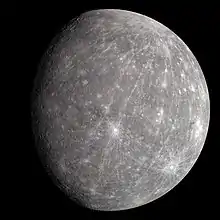 Planet Mercury image by MESSENGER, 2008
Planet Mercury image by MESSENGER, 2008 Planet Venus image by Mariner 10, 1974
Planet Venus image by Mariner 10, 1974.jpg.webp) Planet Earth image by Apollo 17 crew, 1972
Planet Earth image by Apollo 17 crew, 1972.jpg.webp) Moon (earth) image by Apollo 8 crew, 1968
Moon (earth) image by Apollo 8 crew, 1968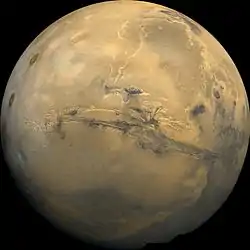 Planet Mars image by Viking 1, 1976
Planet Mars image by Viking 1, 1976.jpg.webp) 433 Eros image by NEAR Shoemaker, 2000
433 Eros image by NEAR Shoemaker, 2000 Ceres dwarf planet image by Dawn, 2015
Ceres dwarf planet image by Dawn, 2015 Planet Jupiter image by Juno, 2019
Planet Jupiter image by Juno, 2019 Moon Io (Jupiter) image by Galileo, 1999
Moon Io (Jupiter) image by Galileo, 1999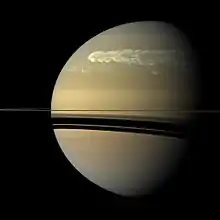 Planet Saturn image by Cassini, 2016
Planet Saturn image by Cassini, 2016 Moon Mimas (saturn) image by Cassini, 2010
Moon Mimas (saturn) image by Cassini, 2010_-_JPEG_converted.jpg.webp) Planet Uranus by Voyager 2, 1986
Planet Uranus by Voyager 2, 1986_flatten_crop.jpg.webp) Planet Neptune image by Voyager 2, 1989
Planet Neptune image by Voyager 2, 1989 Pluto dwarf planet image by New Horizons, 2015
Pluto dwarf planet image by New Horizons, 2015
.jpg.webp) Helix Nebula by Spitzer Space Telescope, 2007
Helix Nebula by Spitzer Space Telescope, 2007 1901 GK Persei supernova by CXO, 2015
1901 GK Persei supernova by CXO, 2015.jpg.webp) Carina Nebula by HST, 2010
Carina Nebula by HST, 2010 Stephens quintet by JWST, Jul 2022
Stephens quintet by JWST, Jul 2022
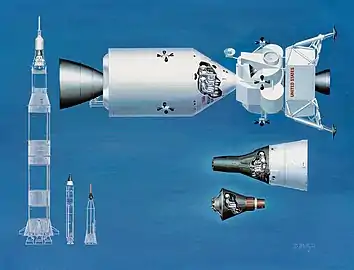
 Surveyor 3, Pete Conrad, and Apollo 12 on the Moon, 1969
Surveyor 3, Pete Conrad, and Apollo 12 on the Moon, 1969.jpg.webp) Space Shuttle Endeavor in orbit, 2008
Space Shuttle Endeavor in orbit, 2008 Hubble Space Telescope released in orbit after servicing, 2009.
Hubble Space Telescope released in orbit after servicing, 2009.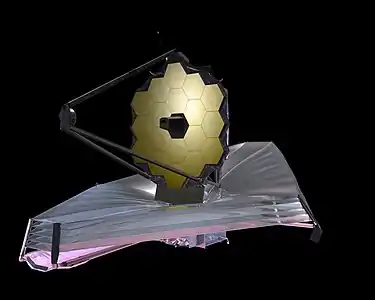 James Webb Space Telescope now in orbit, 2022.
James Webb Space Telescope now in orbit, 2022.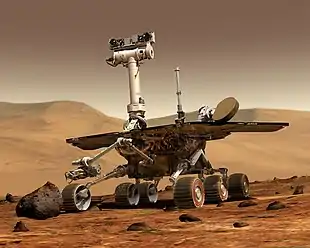 Opportunity rover on surface of Mars (rendering), 2003
Opportunity rover on surface of Mars (rendering), 2003_(51084526931).jpg.webp) Curiosity rover self portrait on Mars, 2021
Curiosity rover self portrait on Mars, 2021.jpg.webp) Perseverance rover during Mars skycrane landing, Feb 2021
Perseverance rover during Mars skycrane landing, Feb 2021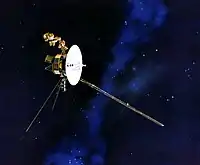 Voyager 2, now 19.5 billion kilometers from home, Jul 2022
Voyager 2, now 19.5 billion kilometers from home, Jul 2022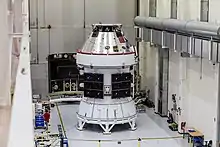 Orion spacecraft and European Service Module testing, 2020
Orion spacecraft and European Service Module testing, 2020
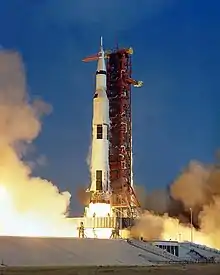
 Titan III/Centaur launching Voyager 2 spacecraft, Jul 1977
Titan III/Centaur launching Voyager 2 spacecraft, Jul 1977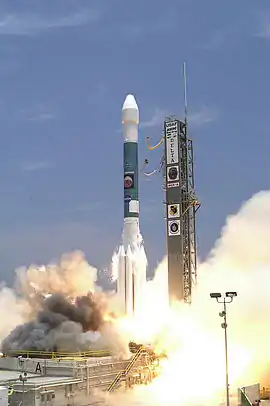 Delta II launching Spirit Rover, Jun 2003
Delta II launching Spirit Rover, Jun 2003 Space Shuttle (STS-124) during launch, May 2008
Space Shuttle (STS-124) during launch, May 2008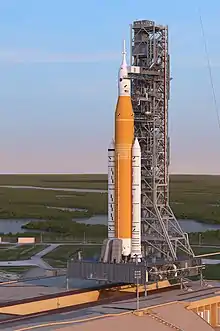 Space Launch System rocket (rendering)
Space Launch System rocket (rendering)
 Concept of space tug cargo transport to a Nuclear Shuttle, 1960s
Concept of space tug cargo transport to a Nuclear Shuttle, 1960s Space Tug concept, 1970s
Space Tug concept, 1970s.png.webp) NASA Interstellar probe concept, 2022
NASA Interstellar probe concept, 2022 Langley's Mars Ice Dome design for a Mars habitat, 2010s
Langley's Mars Ice Dome design for a Mars habitat, 2010s.png.webp) Lunar Gateway space station, 2020
Lunar Gateway space station, 2020 NASA lunar outpost concept, 2006
NASA lunar outpost concept, 2006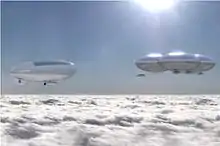 NASA concept for crewed floating outpost on Venus, 2014
NASA concept for crewed floating outpost on Venus, 2014.jpg.webp) NASA concept for 2069 Alpha Centauri solar sail mission
NASA concept for 2069 Alpha Centauri solar sail mission
See also
- List of crewed spacecraft
- List of NASA aircraft
- List of space disasters
- List of United States rockets
- Category:NASA people
- NASA Advanced Space Transportation Program
- NASA Art Program
- NASA Research Park – Research park near San Jose, California
- TechPort (NASA) – Technology Portfolio System
Explanatory notes
- NASA is an independent agency that is not a part of any executive department, but reports directly to the President.[5][6]
- The descent stage of the LM stayed on the Moon after landing, while the ascent stage brought the two astronauts back to the CSM and then was discarded in lunar orbit.
- Orbital Sciences was awarded a CRS contract in 2008. In 2015, Orbital Sciences became Orbital ATK through a business merger. Orbital ATK was awarded a CRS-2 contract in 2016. In 2018, Orbital ATK was acquired by Northrop Grumman.
- NASA EDGE Cast and Crew: Chris Giersch (Host); Blair Allen (Co-host and senior producer); Franklin Fitzgerald (News anchor and "everyman"); Jaqueline Mirielle Cortez (Special co-host); Ron Beard (Director and "set therapist"); and Don Morrison (Audio/video engineer)[337]
- From left to right: Launch vehicle of Apollo (Saturn 5), Gemini (Titan 2) and Mercury (Atlas). Left, top-down: Spacecraft of Apollo, Gemini and Mercury. The Saturn IB and Mercury-Redstone launch vehicles are left out.
References
- US Centennial of Flight Commission, NACA Archived February 20, 2014, at the Wayback Machine. centennialofflight.net. Retrieved on November 3, 2011.
- "Our Missions and Values". nasa.gov. Retrieved October 6, 2022.
- "Workforce Profile". NASA. Archived from the original on August 11, 2022. Retrieved August 11, 2022.
- "NASA's FY 2022 Budget". The Planetary Society. Archived from the original on May 28, 2021. Retrieved June 28, 2022.
- "Official US Executive Branch Web Sites – Newspaper and Current Periodical Reading Room (Serial and Government Publications Division, Library of Congress)". loc.gov. Archived from the original on May 16, 2016. Retrieved May 24, 2016.
- "Frequently Asked Questions". hq.nasa.gov. Archived from the original on May 4, 2016. Retrieved May 24, 2016.
- "Ike in History: Eisenhower Creates NASA". Eisenhower Memorial. 2013. Archived from the original on November 19, 2013. Retrieved November 27, 2013.
- "The National Aeronautics and Space Act". NASA. 2005. Archived from the original on August 16, 2007. Retrieved August 29, 2007.
- Bilstein, Roger E. (1996). "From NACA to NASA". NASA SP-4206, Stages to Saturn: A Technological History of the Apollo/Saturn Launch Vehicles. NASA. pp. 32–33. ISBN 978-0-16-004259-1. Archived from the original on July 14, 2019. Retrieved May 6, 2013.
- Netting, Ruth (June 30, 2009). "Earth—NASA Science". Archived from the original on July 16, 2009. Retrieved July 15, 2009.
- Netting, Ruth (January 8, 2009). "Heliophysics—NASA Science". Archived from the original on July 16, 2009. Retrieved July 15, 2009.
- Roston, Michael (August 28, 2015). "NASA's Next Horizon in Space". The New York Times. Archived from the original on August 29, 2015. Retrieved August 28, 2015.
- Netting, Ruth (July 13, 2009). "Astrophysics—NASA Science". Archived from the original on July 16, 2009. Retrieved July 15, 2009.
- Shouse, Mary (July 9, 2009). "Welcome to NASA Headquarters". Archived from the original on July 13, 2009. Retrieved July 15, 2009.
- Information for Non U.S. Citizens Archived October 7, 2018, at the Wayback Machine, NASA (downloaded September 16, 2013)
- "National Aeronautics and Space Act". Title II Sec. 202 (a), Title of July 29, 1958. 85th Congress of the United States. Archived from the original on September 17, 2020. Retrieved September 11, 2020. Archived September 17, 2020, at the Wayback Machine
- Bartels, Meghan (March 19, 2021). "President Biden nominates Bill Nelson to serve as NASA chief". space.com. Retrieved September 6, 2022.
- "NASA FY2022 Strategic Plan" (PDF). Retrieved September 2, 2022.
- "Budget of the U.S. Government". us.gov. Retrieved September 6, 2022.
- "NASA FY2018 Budget Estimates" (PDF). Retrieved September 2, 2022.
- "NASA FY2019 Budget Estimates" (PDF). Retrieved September 2, 2022.
- "NASA Equal Employment Opportunity Strategic Plan: FY 2018-19" (PDF). Retrieved September 2, 2022.
- "NASA FY2020 Budget Estimates" (PDF). Retrieved September 2, 2022.
- "NASA Model Equal Employment Opportunity Program Status Report: FY2019" (PDF). Retrieved September 2, 2022.
- "NASA FY2021 Budget Estimates" (PDF). Retrieved September 2, 2022.
- "NASA Model Equal Employment Opportunity Program Status Report: FY2020" (PDF). Retrieved September 2, 2022.
- "NASA FY2022 Budget Estimates" (PDF). Retrieved September 2, 2022.
- "NASA Model Equal Employment Opportunity Program Status Report: FY2021" (PDF). Retrieved September 2, 2022.
- Smith, Marcia (March 9, 2022). "NASA to get $24 billion for FY2022, more than last year but less than Biden Wanted". SpacePolicyOnline.com. Retrieved September 6, 2022.
- "NASA Administrator Names Robert Pearce Head of Agency Aeronautics". NASA. December 10, 2019. Retrieved September 6, 2022 – via prnewswire.
- Smith, Marcia (September 21, 2021). "NASA Splits Human Spaceflight Directorate into Two". Space Policy Online. Retrieved September 6, 2022.
- Smith, Marcia (September 27, 2016). "Thomas Zurbuchen Appointed as New Head of Science at NASA". Space Policy Online. Retrieved September 6, 2022.
- "James Reuter, Associate Administrator, STMD, NASA HQ". nasa.gov. November 29, 2021. Retrieved September 7, 2022.
- "NASA executive discusses his approach to leadership". Federal News Network. June 21, 2022. Retrieved September 7, 2022.
- Clemens, Jay (May 5, 2015). "Eugene Tu Named Director of NASA Ames Research Center; Charles Bolden Comments". ExecutiveGov. Retrieved September 6, 2022.
- "NASA Announces Armstrong Flight Research Center Director to Retire". NASA.gov. May 23, 2022. Retrieved September 6, 2022.
- Suttle, Scott (May 22, 2022). "NASA names two interim leaders for Glenn Research Center". Crain's Cleveland Business. Retrieved September 6, 2022.
- "NASA Names Dennis Andrucyk New Goddard Space Flight Center Director". spaceref.com. January 23, 2020. Retrieved September 6, 2022.
- "WPI president to step down to become director of JPL". ap news. January 29, 2022. Retrieved September 6, 2022.
- Hagerty, Michael (August 26, 2021). "Vanessa Wyche Takes The Helm At NASA's Johnson Space Center". Houston Public Media. Retrieved September 6, 2022.
- "First Woman to Lead NASA's Kennedy Space Center Is a BU Alum". Bostonia. July 16, 2021. Retrieved September 6, 2022.
- Dietrich, Tamara (September 9, 2019). "NASA Langley gets a new director". Daily Press. Retrieved September 6, 2022.
- Beck, Caroline (September 14, 2018). "Jody Singer appointed first female director of Marshall Space Flight Center". Alabama Daily News. Retrieved September 6, 2022.
- "Stennis Space Center Announces New Senior Executive Service Appointment". Biz New Orleans. August 26, 2021. Retrieved September 6, 2022.
- "The NACA, NASA, and the Supersonic-Hypersonic Frontier" (PDF). NASA. Archived (PDF) from the original on June 18, 2020. Retrieved September 30, 2011.
- Roger D. Launius, "Eisenhower, Sputnik, and the Creation of NASA." Prologue-Quarterly of the National Archives 28.2 (1996): 127–143.
- Erickson, Mark (2005). Into the Unknown Together—The DOD, NASA, and Early Spaceflight (PDF). ISBN 978-1-58566-140-4. Archived from the original (PDF) on September 20, 2009.
- Subcommittee On Military Construction, United States. Congress. Senate. Committee on Armed Services (January 21–24, 1958). Supplemental military construction authorization (Air Force).: Hearings, Eighty-fifth Congress, second session, on H.R. 9739. Archived from the original on September 5, 2015. Retrieved June 27, 2015.
- "U.S. makes ready to launch program for outer space conquest". upi. July 29, 1958. Retrieved September 7, 2022.
- "T. Keith Glennan". NASA. August 4, 2006. Archived from the original on February 14, 2017. Retrieved July 15, 2009.
- von Braun, Werner (1963). "Recollections of Childhood: Early Experiences in Rocketry as Told by Werner Von Braun 1963". MSFC History Office. NASA Marshall Space Flight Center. Archived from the original on July 9, 2009. Retrieved July 15, 2009.
- Van Atta, Richard (April 10, 2008). "50 years of Bridging the Gap" (PDF). Archived from the original (PDF) on February 24, 2009. Retrieved July 15, 2009.
- "T. Keith Glennan biography". NASA. August 4, 2006. Archived from the original on February 14, 2017. Retrieved July 5, 2008.
- Williams, Christian (September 24, 1981). "James Webb and NASA's Reach For The Moon". Washington Post. Retrieved October 4, 2022.
- "James C. Fletcher biography". NASA. Archived from the original on July 6, 2008. Retrieved July 5, 2008.
- "Daniel S. Goldin biography". NASA. March 12, 2004. Archived from the original on June 15, 2008. Retrieved July 5, 2008.
- Executive Order 10849 (Wikisource)
- Executive Order 10942 (Wikisource)
- Garber, Steve. "NASA "Meatball" Logo". NASA History Program Office. NASA. Archived from the original on November 12, 2020. Retrieved October 15, 2015.
- Chang, Kenneth (April 8, 2020). "NASA's 'Worm' Logo Will Return to Space – The new old logo, dropped in the 1990s in favor of a more vintage brand, will adorn a SpaceX rocket that is to carry astronauts to the space station in May". The New York Times. Archived from the original on October 27, 2020. Retrieved April 8, 2020.
- "NASA Facilities and Centers" (PDF). NASA. Archived (PDF) from the original on October 25, 2020. Retrieved July 30, 2020.
- Tillman, Nola (January 12, 2018). "Ames Research Center: R&D Lab for NASA". space.com. Retrieved September 7, 2022.
- "NASA Glenn's Historical Timeline". NASA. April 16, 2015. Retrieved September 4, 2022.
- Fentress, Steve (February 10, 2020). "NASA's Goddard Space Flight Center: Exploring Earth and space by remote control". space.com. Retrieved September 8, 2022.
- "6 decades of space and Houston: JSC celebrates anniversary with big bash". KHOU Channel 11. April 28, 2022. Retrieved September 8, 2022.
- NASA. "Lyndon B. Johnson Space Center". Archived from the original on September 8, 2012. Retrieved August 27, 2008.
- Voosen, Paul (June 3, 2022). "New director of NASA's storied Jet Propulsion Lab takes on ballooning mission costs". science.com. Retrieved September 7, 2022.
- Rothman, Lily (January 5, 2017). "What to Know About the Real Research Lab From Hidden Figures". time.com. Retrieved September 8, 2022.
- "Kennedy Space Center Story". NASA. 1991. Archived from the original on May 20, 2017. Retrieved November 5, 2015.
- Fentress, Steve (July 6, 2021). "NASA's Marshall Space Flight Center: A hub for historic and modern-day rocket power". space.com. Retrieved September 8, 2022.
- Glorioso, Mark (October 19, 2020). "The path to the moon runs through Mississippi". Hattiesburg American. Retrieved September 8, 2022.
- Lopez, Kenny (August 9, 2022). "Stennis Space Center tests rocket engines that will be used in NASA's historic Artemis I mission to the moon". WGNO TV. Retrieved September 4, 2022.
- "Stennis Space Center set for active testing year". Meridian Star. January 22, 2022. Retrieved September 4, 2022.
- Dubuisson, Rebecca (July 19, 2007). "NASA Shared Services Center Background". Archived from the original on July 16, 2009. Retrieved July 15, 2009.
- "X-15 launch from B-52 mothership". Armstrong Flight Research Center. February 6, 2002. Photo E-4942. Archived from the original on May 27, 2021. Retrieved August 30, 2021.
- Aircraft Museum X-15." Archived September 21, 2011, at the Wayback Machine Aerospaceweb.org, November 24, 2008.
- NASA, X-15 Hypersonic Research Program Archived October 7, 2018, at the Wayback Machine, retrieved October 17, 2011
- Aerospaceweb, North American X-15 Archived September 21, 2011, at the Wayback Machine. Aerospaceweb.org. Retrieved on November 3, 2011.
- Encyclopedia Astronautica, Project 7969 Archived October 11, 2011, at the Wayback Machine, retrieved October 17, 2011
- NASA, Project Mercury Overview Archived June 3, 2013, at the Wayback Machine, retrieved October 17, 2011
- Swenson Jr., Loyd S.; Grimwood, James M.; Alexander, Charles C. (1989). "11-4 Shepard's Ride". In Woods, David; Gamble, Chris (eds.). This New Ocean: A History of Project Mercury (url). Published as NASA Special Publication-4201 in the NASA History Series. NASA. Archived from the original on July 13, 2009. Retrieved July 14, 2009.
- Swenson Jr., Loyd S.; Grimwood, James M.; Alexander, Charles C. (1989). "13-4 An American in Orbit". In Woods, David; Gamble, Chris (eds.). This New Ocean: A History of Project Mercury (url). Published as NASA Special Publication-4201 in the NASA History Series. NASA. Archived from the original on July 13, 2009. Retrieved July 14, 2009.
- "Mercury Manned Flights Summary". NASA. Archived from the original on September 16, 2011. Retrieved October 9, 2011.
- Loff, Sarah (November 22, 2016). "Katherine Johnson Biography". NASA. Archived from the original on March 31, 2019. Retrieved March 8, 2019.
- Loff, Sarah (November 22, 2016). "Mary Jackson Biography". NASA. Archived from the original on January 20, 2019. Retrieved March 8, 2019.
- Loff, Sarah (November 22, 2016). "Dorothy Vaughan Biography". NASA. Archived from the original on November 30, 2018. Retrieved March 8, 2019.
- "NASA history, Gagarin". NASA. Archived from the original on October 25, 2011. Retrieved October 9, 2011.
- "Joint flight of Vostok-3 and Vostok-4". russianspaceweb.com. December 1, 2020. Retrieved October 1, 2022.
- Barton C. Hacker; James M. Grimwood (December 31, 2002). "10-1 The Last Hurdle". On the Shoulders of Titans: A History of Project Gemini (url). NASA. ISBN 978-0-16-067157-9. Archived from the original on January 13, 2010. Retrieved July 14, 2009.
- Barton C. Hacker; James M. Grimwood (December 31, 2002). "12-5 Two Weeks in a Spacecraft". On the Shoulders of Titans: A History of Project Gemini. NASA. ISBN 978-0-16-067157-9. Archived from the original on January 13, 2010. Retrieved July 14, 2009.
- Barton C. Hacker; James M. Grimwood (December 31, 2002). "13-3 An Alternative Target". On the Shoulders of Titans: A History of Project Gemini. NASA. ISBN 978-0-16-067157-9. Archived from the original on January 13, 2010. Retrieved July 14, 2009.
- Mann, Adam (October 1, 2020). "Voskhod program: The Soviet Union's first crewed space program". space.com. Retrieved October 2, 2022.
- "The Decision to Go to the Moon: President John F. Kennedy's May 25, 1961 Speech before Congress". history.nasa.gov. Archived from the original on May 23, 2020. Retrieved June 3, 2020.
- John F. Kennedy "Landing a man on the Moon" Address to Congress on YouTube, speech
- Butts, Glenn; Linton, Kent (April 28, 2009). "The Joint Confidence Level Paradox: A History of Denial, 2009 NASA Cost Symposium" (PDF). pp. 25–26. Archived from the original (PDF) on October 26, 2011. Retrieved December 23, 2021.
- 1634–1699: McCusker, J. J. (1997). How Much Is That in Real Money? A Historical Price Index for Use as a Deflator of Money Values in the Economy of the United States: Addenda et Corrigenda (PDF). American Antiquarian Society. 1700–1799: McCusker, J. J. (1992). How Much Is That in Real Money? A Historical Price Index for Use as a Deflator of Money Values in the Economy of the United States (PDF). American Antiquarian Society. 1800–present: Federal Reserve Bank of Minneapolis. "Consumer Price Index (estimate) 1800–". Retrieved April 16, 2022.
- Nichols, Kenneth David (1987). The Road to Trinity: A Personal Account of How America's Nuclear Policies Were Made, pp 34–35. New York: William Morrow and Company. ISBN 978-0-688-06910-0. OCLC 15223648.
- "Saturn V". Encyclopedia Astronautica. Archived from the original on October 7, 2011. Retrieved October 13, 2011.
- "Apollo 1". NASA. March 16, 2015. Archived from the original on February 3, 2017. Retrieved May 16, 2022.
- "Apollo 8: The First Lunar Voyage". NASA. Archived from the original on October 27, 2011. Retrieved October 13, 2011.
- Siddiqi, Asif A. (2003). The Soviet Space Race with Apollo. Gainesville: University Press of Florida. pp. 654–656. ISBN 978-0-8130-2628-2.
- "Apollo 9: Earth Orbital trials". NASA. Archived from the original on October 27, 2011. Retrieved October 13, 2011.
- "Apollo 10: The Dress Rehearsal". NASA. Archived from the original on October 27, 2011. Retrieved October 13, 2011.
- "The First Landing". NASA. Archived from the original on October 27, 2011. Retrieved October 13, 2011.
- Arriclucea, Eva (January 2018). Case Study Report: Apollo Project (US) (PDF). European Commission. p. 10. doi:10.2777/568253. ISBN 978-92-79-80155-6. Retrieved October 2, 2022.
- The Phrase Finder: Archived September 24, 2011, at the Wayback Machine ... a giant leap for mankind, retrieved October 1, 2011
- Siddiqi, Asif (June 2019). "Why the Soviets Lost the Moon Race". Smithsonian Magazine. Retrieved October 2, 2022.
- 30th Anniversary of Apollo 11, Manned Apollo Missions Archived February 20, 2011, at the Wayback Machine. NASA, 1999.
- Belew, Leland F., ed. (1977). Skylab Our First Space Station—NASA report (PDF). NASA. NASA-SP-400. Archived (PDF) from the original on March 17, 2010. Retrieved July 15, 2009.
- Benson, Charles Dunlap and William David Compton. Living and Working in Space: A History of Skylab Archived November 5, 2015, at the Wayback Machine. NASA publication SP-4208.
- "50 Years Ago: After Apollo, What? Space Task Group Report to President Nixon". nasa.gov. September 18, 2019. Retrieved October 1, 2022.
- Gatland, Kenneth (1976). Manned Spacecraft, Second Revision. New York: Macmillan Publishing Co., Inc. p. 247. ISBN 978-0-02-542820-1.
- Grinter, Kay (April 23, 2003). "The Apollo Soyuz Test Project". Archived from the original on July 25, 2009. Retrieved July 15, 2009.
- NASA, Shuttle-MIR history Archived October 7, 2018, at the Wayback Machine, retrieved October 15, 2011
- Encyclopedia Astronautica, Vostok 1 Archived October 28, 2011, at the Wayback Machine, retrieved October 18, 2011
- NASA, Shuttle Basics Archived October 7, 2018, at the Wayback Machine, retrieved October 18, 2011
- Encyclopedia Astronautica, Shuttle Archived April 7, 2004, at the Wayback Machine, retrieved October 18, 2011
- Encyclopedia Astronautica, Spacelab Archived October 11, 2011, at the Wayback Machine. Retrieved October 20, 2011
- Spaceflight, Kim Ann Zimmermann 2018-01-19T02:02:00Z (January 19, 2018). "Sally Ride: First American Woman in Space". Space.com. Archived from the original on March 8, 2019. Retrieved March 8, 2019.
- Encyclopedia Astronautica, HST Archived October 11, 2011, at the Wayback Machine. Retrieved October 20, 2011
- "Partnering with Russia". clintonpresidentiallibraries.us. January 24, 1994. Retrieved October 1, 2022.
- Watson, Traci (January 8, 2008). "Shuttle delays endanger space station". USA Today. Archived from the original on March 26, 2009. Retrieved July 15, 2009.
- "NASA's Last Space Shuttle Flight Lifts Off From Cape Canaveral". KHITS Chicago. July 8, 2011. Archived from the original on July 14, 2011.
- Connolly, John F. (October 2006). "Constellation Program Overview" (PDF). Constellation Program Office. Archived from the original (PDF) on July 10, 2007. Retrieved July 6, 2009.
- NASA Office of Public Affairs (December 4, 2006). "Global Exploration Strategy and Lunar Architecture" (PDF). NASA. Archived (PDF) from the original on June 24, 2009. Retrieved July 15, 2009.
- "Review of United States Human Space Flight Plans Committee" (PDF). Office of Science and Technology Policy. October 22, 2009. Archived (PDF) from the original on December 13, 2011. Retrieved December 13, 2011.
- Achenbach, Joel (February 1, 2010). "NASA budget for 2011 eliminates funds for manned lunar missions". Washington Post. Archived from the original on March 21, 2010. Retrieved February 1, 2010.
- "President Barack Obama on Space Exploration in the 21st Century". Office of the Press Secretary. April 15, 2010. Archived from the original on July 19, 2012. Retrieved July 4, 2012.
- "Today – President Signs NASA 2010 Authorization Act". Universetoday.com. Archived from the original on February 5, 2021. Retrieved November 20, 2010.
- Svitak, Amy (March 31, 2011). "Holdren: NASA Law Doesn't Square with Budgetary Reality". Space News. Archived from the original on May 26, 2012. Retrieved July 4, 2012.
- "NASA Announces Design for New Deep Space Exploration System". NASA. September 14, 2011. Archived from the original on April 13, 2012. Retrieved April 28, 2012.
- Bergin, Chris (February 23, 2012). "Acronyms to Ascent – SLS managers create development milestone roadmap". NASA. Archived from the original on April 30, 2012. Retrieved April 29, 2012.
- Jeff Foust (June 14, 2017). "NASA closing out Asteroid Redirect Mission". Space News. Archived from the original on June 15, 2017. Retrieved September 9, 2017.
- "Launch History (Cumulative)" (PDF). NASA. Archived (PDF) from the original on October 19, 2011. Retrieved September 30, 2011.
- "NASA, Explorers program". NASA. Archived from the original on September 27, 2011. Retrieved September 20, 2011.
- "Rangers and Surveyors to the Moon" (PDF). NASA. Archived (PDF) from the original on May 25, 2018. Retrieved February 25, 2018.
- "Syncom 3". nasa.gov. April 2022. Retrieved October 3, 2022.
- "NASA Experimental Communications Satellites, 1958–1995". NASA. Archived from the original on August 4, 2011. Retrieved September 30, 2011.
- "JPL, Chapter 4. Interplanetary Trajectories". NASA. Archived from the original on September 3, 2011. Retrieved September 30, 2011.
- "Magellan Mission at a Glance". Jet Propulsion Laboratory. Retrieved October 10, 2022.
- "MESSENGER". nasa.gov. August 1, 2019. Retrieved October 10, 2022.
- Kloman (1972). "NASA Unmanned Space Project Management - Surveyor and Lunar Orbiter" (PDF). NASA SP-4901.
- "The Clementine Mission". Lunar and Planetary Institute. Retrieved October 10, 2022.
- "Lunar Prospector". nasa.gov. July 11, 2019. Retrieved October 10, 2022.
- "Missions to Mars". The Planet Society. Archived from the original on January 18, 2012. Retrieved September 30, 2011.
- "Missions to Jupiter". The Planet Society. Archived from the original on October 6, 2011. Retrieved September 30, 2011.
- "JPL Voyager". JPL. Archived from the original on October 8, 2011. Retrieved September 30, 2011.
- "Pioneer 10 spacecraft send last signal". NASA. Archived from the original on November 9, 2016. Retrieved September 30, 2011.
- "The golden record". JPL. Archived from the original on September 27, 2011. Retrieved September 30, 2011.
- "New Horizon". JHU/APL. Archived from the original on May 9, 2010. Retrieved September 30, 2011.
- "Voyages Beyond the Solar System: The Voyager Interstellar Mission". NASA. Archived from the original on September 27, 2011. Retrieved September 30, 2011.
- Ousley, G. W.; Kutzer, A.; Panitz, H. J. (October 1976). "The Helios program and the sun". International Astronautical Federation, International Astronautical Congress, 27th, Anaheim, Calif., Oct. 10-16, 1976, 11 P. Bibcode:1976anah.iafcR....O. Retrieved October 21, 2022.
- "Fast Auroral SnapshoT Explorer (FAST) Data Archive". nasa.gov. Retrieved October 21, 2022.
- "ISEE-3 / ICE". European Space Agency. November 26, 2014. Retrieved October 22, 2022.
- "Ulysses overview". European Space Agency. Retrieved October 22, 2022.
- "CRRES". NASA. Retrieved October 23, 2022.
- "UARS". European Space Agency. June 13, 2012. Retrieved October 23, 2022.
- "TOPEX/POSEIDON" (PDF). nasa.gov. Retrieved October 23, 2022.
- Clark, Stephen (February 25, 2010). "ICESat mission complete after seven years in orbit". Spaceflight Now. Retrieved October 22, 2022.
- Catchpole, John E. (June 17, 2008). The International Space Station: Building for the Future. Springer-Praxis. pp. 1–2. ISBN 978-0-387-78144-0.
- "Human Spaceflight and Exploration—European Participating States". European Space Agency (ESA). 2009. Archived from the original on July 30, 2012. Retrieved January 17, 2009.
- Gary Kitmacher (2006). Reference Guide to the International Space Station. Apogee Books Space Series. Canada: Apogee Books. pp. 71–80. ISBN 978-1-894959-34-6. ISSN 1496-6921.
- "ISS Intergovernmental Agreement". European Space Agency (ESA). April 19, 2009. Archived from the original on June 10, 2009. Retrieved April 19, 2009.
- "Memorandum of Understanding Between the National Aeronautics and Space Administration of the United States of America and the Russian Space Agency Concerning Cooperation on the Civil International Space Station". NASA. January 29, 1998. Archived from the original on June 10, 2009. Retrieved April 19, 2009.
- Zak, Anatoly (October 15, 2008). "Russian Segment: Enterprise". RussianSpaceWeb. Archived from the original on September 20, 2012. Retrieved August 4, 2012.
- "ISS Fact sheet: FS-2011-06-009-JSC" (PDF). NASA. 2011. Archived (PDF) from the original on May 10, 2013. Retrieved September 2, 2012.
- "MCB Joint Statement Representing Common Views on the Future of the ISS" (PDF). International Space Station Multilateral Coordination Board. February 3, 2010. Archived (PDF) from the original on November 16, 2012. Retrieved August 16, 2012.
- Leone, Dan (June 20, 2012). "Wed, 20 June, 2012 NASA Banking on Commercial Crew To Grow ISS Population". Space News. Archived from the original on January 5, 2013. Retrieved September 1, 2012.
- "Nations Around the World Mark 10th Anniversary of International Space Station". NASA. November 17, 2008. Archived from the original on February 13, 2009. Retrieved March 6, 2009.
- Boyle, Rebecca (November 11, 2010). "The International Space Station Has Been Continuously Inhabited for Ten Years Today". Popular Science. Archived from the original on March 18, 2013. Retrieved September 1, 2012.
- International Space Station Archived February 24, 2009, at the Wayback Machine, Retrieved October 20, 2011
- de Selding, Peter B. (August 12, 2014). "After Maneuvers, Final ATV Docks with Station". Space News. Retrieved October 2, 2022.
- Clark, Stephen (May 25, 2020). "HTV supply ship successfully berthed at space station". SpaceFlightNow.com. Retrieved October 2, 2022.
- Chow, Denise (November 17, 2011). "U.S. Human Spaceflight Program Still Strong, NASA Chief Says". Space.com. Archived from the original on June 25, 2012. Retrieved July 2, 2012.
- Potter, Ned (July 17, 2009). "Space Shuttle, Station Dock: 13 Astronauts Together". ABC News. Archived from the original on June 30, 2017. Retrieved September 7, 2012.
- Nelson, Bill [@SenBillNelson] (December 20, 2018). "Commercial Space Company Bill Announcement" (Tweet) – via Twitter.
- Foust, Jeff (August 20, 2022). "NASA asks industry for input on ISS deorbit capabilities". Space News. Retrieved October 2, 2022.
- Jason Rhian (September 27, 2014). "NASA continues Commercial "push" with CRS extension". Spaceflight Insider.
- "SpaceX, NASA Target Oct. 7 Launch For Resupply Mission To Space Station". NASA. September 20, 2012. Retrieved September 26, 2012.
- Malik, Tariq (January 20, 2014). "Orbital's Cygnus Delivers Gifts, Ants To Station in First Commercial Run". spacenews.com. Retrieved September 3, 2022.
- Bergin, Chris. "NASA lines up four additional CRS missions for Dragon and Cygnus". NASASpaceFlight.com. Retrieved April 19, 2015.
- de Selding, Peter B. (February 24, 2016). "SpaceX wins 5 new space station cargo missions in NASA contract estimated at $700 million". SpaceNews. Retrieved October 11, 2022.
- Alamalhodaei, Aria (March 25, 2022). "SpaceX, Northrop Grumman to resupply the ISS through 2026". Tech Crunch. Retrieved October 11, 2022.
- Burghardt, Thomas (February 19, 2022). "Northrop Grumman Cygnus NG-17 arrives at ISS". NASA Spaceflight. Retrieved October 11, 2022.
- Kanayama, Lee (July 14, 2022). "SpaceX and NASA launch CRS-25 mission to the ISS". NASA Spaceflight. Retrieved October 11, 2022.
- Foust, Jeff (April 29, 2022). "First Dream Chaser vehicle takes shape". Space News. Retrieved October 11, 2022.
- "NASA Chooses American Companies to Transport U.S. Astronauts to International Space Station". NASA. September 16, 2014. Retrieved October 2, 2022.
- Foust, Jeff (September 1, 2022). ""NASA and SpaceX finalize extension of commercial crew contract"". spacenews.com. Retrieved October 1, 2022.
- Haskell, Matt (November 16, 2020). "SpaceX Successfully Launches First Operational Crewed Mission". spaceflightinsider.com. Retrieved October 2, 2022.
- Foust, Jeff (May 25, 2022). "Starliner concludes OFT-2 test flight with landing in New Mexico". Space News. Retrieved October 2, 2022.
- "NASA: Moon to Mars". NASA. Archived from the original on August 5, 2019. Retrieved May 19, 2019.
- "Hopeful for launch next year, NASA aims to resume SLS operations within weeks". May 1, 2020. Archived from the original on September 13, 2020. Retrieved September 2, 2020.
- Whitwam, Ryan. NASA Sets New Roadmap for Moon Base, Crewed Missions to Mars Archived November 27, 2018, at the Wayback Machine Extreme Tech, September 27, 2018. Accessed November 26, 2018.
- "NASA builds deep space habitats on Earth". Archived from the original on February 24, 2017. Retrieved December 30, 2016.
- "US Government Issues NASA Demand, 'Get Humans to Mars By 2033'". March 9, 2017. Archived from the original on February 17, 2018. Retrieved February 16, 2018.
- "Trump Signs NASA Authorization act of 2017". Spaceflight Insider. March 21, 2017. Archived from the original on December 3, 2018. Retrieved December 2, 2018.
- Foust, Jeff (November 18, 2021). "NASA selects Intuitive Machines for CLPS lunar landing mission". SpaceNews. Archived from the original on September 1, 2022. Retrieved March 17, 2022.
- "As Artemis Moves Forward, NASA Picks SpaceX to Land Next Americans on Moon". NASA. April 16, 2021. Archived from the original on April 16, 2021. Retrieved November 16, 2021.
- "NASA delays human lunar landing to at least 2025". spacenews.com. November 9, 2021. Archived from the original on September 1, 2022. Retrieved November 16, 2021.
- "Space Launch System • Artemis 1". Archived from the original on January 28, 2022. Retrieved January 31, 2022.
- Foust, Jeff (January 20, 2022). "NASA foresees gap in lunar landings after Artemis 3". SpaceNews. Archived from the original on September 1, 2022. Retrieved February 2, 2022.
- "NASA awards funding to three commercial space station concepts". spacenews.com. December 3, 2021. Archived from the original on September 1, 2022. Retrieved December 3, 2021.
- "The Explorers Program". nasa.gov. Retrieved October 10, 2022.
- "Discovery Program". nasa.gov. June 16, 2022. Retrieved October 10, 2022.
- Foust, Jeff (June 2, 2021). "NASA selects two Venus missions for Discovery program". Space News. Retrieved October 11, 2022.
- "New Frontiers Program". nasa.gov. October 4, 2021. Retrieved October 10, 2022.
- "NASA Moves New Frontiers 5 Mission Selection to No Earlier Than 2024". Sci Tech Daily. Retrieved October 11, 2022.
- NASA Staff (November 26, 2011). "Mars Science Laboratory". NASA. Archived from the original on November 27, 2011. Retrieved November 26, 2011.
- "NASA Launches Super-Size Rover to Mars: 'Go, Go!'". The New York Times. Associated Press. November 26, 2011. Retrieved November 26, 2011.
- Kenneth Chang (August 6, 2012). "Curiosity Rover Lands Safely on Mars". The New York Times. Archived from the original on August 6, 2012. Retrieved August 6, 2012.
- Wilson, Jim (September 15, 2008). "NASA Selects 'MAVEN' Mission to Study Mars Atmosphere". NASA. Archived from the original on June 19, 2009. Retrieved July 15, 2009.
- "Success! NASA's Maven Probe Goes Into Orbit Around Mars". NBC News. September 21, 2014. Retrieved October 17, 2022.
- "Dragonfly: Titan Rotorcraft Lander". The Johns Hopkins University Applied Physics Laboratory. 2017. Retrieved September 20, 2017.
- "NASA New Frontiers 5: Third Community Announcement". NASA Science Mission Directorate. May 12, 2021. Retrieved May 14, 2021 – via SpaceRef.
- Foust, Jeff (September 25, 2020). "NASA delays Dragonfly launch by a year". SpaceNews.
- "NASA Astrophysics". nasa.gov. Retrieved October 7, 2022.
- "About - The Hubble Story". nasa.gov. May 26, 2022. Retrieved October 7, 2022.
- "About-Hubble Servicing Missions". nasa.gov. May 26, 2022. Retrieved October 7, 2022.
- Howell, Elizabeth (June 15, 2018). "Chandra Space Telescope: Revealing the Invisible Universe". space.com. Retrieved October 7, 2022.
- Adams, Mitzi (June 16, 2022). "IXPE Home: Expanding the X-ray View of the Universe". nasa.gov. Retrieved October 7, 2022.
- Smith, DeLee (October 7, 2022). "Small Explorers (SMEX) Missions in Development". nasa.gov. Retrieved October 7, 2022.
- Howell, Elizabeth (July 30, 2018). "Swift Observatory: Scanning the Sky for Gamma-ray Bursts". space.com. Retrieved October 7, 2022.
- "Sci Fact Sheet" (PDF). nasa.gov. Retrieved October 7, 2022.
- "FGST: Fermi Gamma-ray Space Telescope". Stanford University. Retrieved October 7, 2022.
- "An Astro-Particle Physics Partnership Exploring the High Energy Universe - List of funders". SLAC. Retrieved August 9, 2007.
- Pinoi, Natasha; Fiser, Alise; Betz, Laura (December 27, 2021). "NASA's Webb Telescope Launches to See First Galaxies, Distant Worlds". NASA. Archived from the original on April 12, 2022. Retrieved March 20, 2022.
- "About – Webb Orbit". NASA. Archived from the original on May 20, 2021. Retrieved June 2, 2021.
- Strickland, Ashley (January 24, 2022). "Telescope reaches its final destination a million miles from Earth". cnn.com. Retrieved October 7, 2022.
- Cooper, Keith (July 28, 2022). "James Webb Space Telescope beats its own record with potential most distant galaxies". space.com. Retrieved October 7, 2022.
- "Aqua satellite provides 20 years of weather and environmental observations". European Centre for Medium-Range Weather Forecasts. May 4, 2022. Retrieved October 8, 2022.
- "Earth Online - Aura". European Space Agency. Retrieved October 8, 2022.
- "Successful Launch: the Orbiting Carbon Observatory (OCO-2)". Commmittee on Earth Observation Satellites. Retrieved October 8, 2022.
- "GRACE FO Fact Sheet". nasa.gov. Retrieved October 8, 2022.
- Garner, Rob (May 21, 2019). "About ICESat-2". nasa.gov. Retrieved October 8, 2022.
- "NASA Earth System Observatory, Addressing, Mitigating Climate Change". nasa.gov. Retrieved October 8, 2022.
- Foust, Jeff (March 1, 2022). "Atlas 5 launches GOES-T weather satellite". Space News. Retrieved October 8, 2022.
- "Earth Science Data Systems (ESDS) Program". nasa.gov. May 25, 2021. Retrieved October 8, 2022.
- "What is the Deep Space Network?". nasa.gov. March 30, 2020. Retrieved October 7, 2022.
- Dickinson, David (September 6, 2021). "NASA's Deep Space Network Upgraded". Sky and Telescope. Retrieved October 7, 2022.
- "What is the Near Space Network?". nasa.gov. February 24, 2021. Retrieved October 9, 2022.
- "Where Are The NSN Complexes Located?". nasa.gov. March 3, 2021. Retrieved October 9, 2022.
- "Near Earth Network Overview". nasa.gov. Retrieved October 9, 2022.
- "Sounding Rockets Program Office". nasa.gov. Retrieved October 7, 2022.
- "NASA Awards Sounding Rocket Operations Contract". nasa.gov. April 6, 2016. Retrieved October 7, 2022.
- Garrick, Matt (July 13, 2022). "NASA's inaugural Northern Territory mission is over, but hopes for a space industry boom remain". ABC News. Australian Broadcasting Corporation. Archived from the original on July 14, 2022. Retrieved July 14, 2022.
- "LSP Overview". nasa.gov. April 10, 2018. Retrieved September 9, 2022.
- "Launch Services Program" (PDF). nasa.gov. Retrieved October 1, 2022.
- "Space Operations Mission Directorate". nasa.gov. February 24, 2022. Retrieved September 9, 2022.
- Foust, Jeff (September 22, 2021). "NASA splits human spaceflight directorate into two organizations". Space News. Retrieved September 11, 2022.
- "About Us". Nasa.gov. NASA. Archived from the original on 12 May 2013. Retrieved 17 June 2016.
- "NASA Armstrong Fact Sheet: NASA X-57 Maxwell". nasa.gov. September 13, 2018. Retrieved October 7, 2022.
- Young, Chris (May 3, 2022). "NASA takes a huge step closer to crewed flight tests for its all-electric X-57 Maxwell". Interesting Engineer. Retrieved October 7, 2022.
- "X-57: Who's on the team?". nasa.gov. Retrieved October 7, 2022.
- "NextGen Annual Report Fiscal Year 2020" (PDF). faa.gov. Retrieved October 8, 2022.
- "Next Generation Air Transportation System (NextGen)". faa.gov. July 20, 2022. Retrieved October 8, 2022.
- Colen, Jerry (August 3, 2017). "Areas of Ames Ingenuity: Next Generation Air Transportation". nasa.gov. Retrieved October 8, 2022.
- "Radioisotope Power Systems for Space Exploration" (PDF). Jet Propulsion Laboratory. March 2011. Archived (PDF) from the original on March 4, 2016. Retrieved March 13, 2015.
- "New Horizons II Final Report – March 2005" (PDF). Archived (PDF) from the original on November 12, 2013. Retrieved November 14, 2016.
- Burghardt, Thomas (July 13, 2021). "NASA Announces Nuclear Thermal Propulsion Reactor Concept Awards". nasa.gov. Retrieved September 5, 2022.
- Nyirady, Annamarie (April 25, 2019). "NASA Awards PathFinder Digital Free Space Optics Contract". Via Satellite. Archived from the original on April 30, 2019. Retrieved April 30, 2019.
- "Nasa moon mission asks US universities to develop technology". The Guardian. July 29, 2020. Archived from the original on August 3, 2020. Retrieved August 3, 2020.
- "NASA 2023 Budget" (PDF). Archived (PDF) from the original on June 11, 2022. Retrieved August 16, 2022.
- "Crew 4 ISS Microgravity Experiments". April 18, 2022. Archived from the original on August 16, 2022. Retrieved August 16, 2022.
- Sarkar, Monica (January 13, 2016). "NASA Planetary Defense Office set up to save Earth". CNN. Retrieved October 8, 2022.
- "Planetary Defense Coordination Office". NASA. December 22, 2015. Retrieved January 14, 2016.
 This article incorporates text from this source, which is in the public domain.
This article incorporates text from this source, which is in the public domain. - "NASA on the Prowl for Near-Earth Objects". NASA/JPL. May 26, 2004. Retrieved October 2, 2022.
- Clark R. Chapman (May 21, 1998). "Statement on The Threat of Impact by Near-Earth Asteroids before the Subcommittee on Space and Aeronautics of the Committee on Science of the U.S. House of Representatives at its hearings on "Asteroids: Perils and Opportunities"". Southwest Research Institute. Retrieved March 6, 2018.
- "WISE Revises Numbers of Asteroids Near Earth". NASA/JPL. September 29, 2011. Archived from the original on December 5, 2017. Retrieved November 9, 2017.
- "Public Law 109–155–DEC.30, 2005" (PDF). Archived (PDF) from the original on December 1, 2017. Retrieved November 9, 2017.
- Leah Crane (January 25, 2020). "Inside the mission to stop killer asteroids from smashing into Earth". New Scientist. See especially this figure.
- Smtih, Marcia (January 19, 2020). "NASA's New NEO Mission Will Substantially Reduce Time to Find Hazardous Asteroids". SpacePolicyOnline.com. Retrieved October 2, 2022.
- Foust, Jeff (September 23, 2019). "NASA to develop mission to search for near-Earth asteroids". Space News. Retrieved October 2, 2022.
- Talbert, Tricia (June 11, 2021). "NASA Approves Asteroid Hunting Space Telescope to Continue Development". NASA. Retrieved October 2, 2022.
 This article incorporates text from this source, which is in the public domain.
This article incorporates text from this source, which is in the public domain. - "In Depth | 433 Eros". NASA Solar System Exploration. Archived from the original on August 20, 2019. Retrieved October 7, 2019.
- "NEAR Shoemaker". NASA. Retrieved April 26, 2021.
- "OSIRIS-REx". NASA. April 14, 2021. Retrieved December 25, 2021.
- "Planetary Defense: The Bennu Experiment". nasa.gov. December 6, 2018. Retrieved October 8, 2022.
- "WISE/NEOWISE". nasa.gov. June 30, 2021. Retrieved October 8, 2022.
- David, Leonard (January 29, 2016). "NASA's New Planetary Defense Office Gets to Work Protecting Earth". space.com. Retrieved October 8, 2022.
- "Double Asteroid Redirection Test (DART)". nasa.gov. April 27, 2022. Retrieved October 8, 2022.
- Strickland, Ashley (November 24, 2021). "NASA launches mission to crash into a near-Earth asteroid to try to change its motion in space". cnn.com. Retrieved October 8, 2022.
- "DART mission: How NASA hit the bullseye". CBS News. October 2, 2022. Retrieved October 2, 2022.
- Finding Asteroids Before They Find Us NEOCam Home site at NASA's Jet Propulsion Laboratory - Caltech
- "NASA not shying away from reputational risk, launches study of UFOs". The Economic Times. Archived from the original on June 10, 2022. Retrieved June 10, 2022.
- Davenport, Christian (June 9, 2022). "NASA joins the hunt for UFOs". The Washington Post. Retrieved September 5, 2022.
- "NASA Aerospace Safety Advisory Panel (ASAP)". oiir.hq.nasa.gov. Archived from the original on March 8, 2017. Retrieved April 13, 2017.
- Mochinski, Ron (April 8, 2015). "About Us – Background and Charter". Archived from the original on December 28, 2015. Retrieved April 13, 2017.
- Erwin, Sandra (May 12, 2020). "Space Force troops preparing for possibility of having to rescue NASA astronauts". SpaceNews. Archived from the original on May 13, 2020. Retrieved February 3, 2021.
- Smith, Marcia (May 5, 2020). "NASA and Space Force to Work Together on Planetary Defense". SpacePolicyOnline.com. Archived from the original on February 26, 2021. Retrieved February 2, 2021.
- Erwin, Sandra (October 1, 2020). "Space Force members can go to the moon, if they're picked by NASA". SpaceNews. Archived from the original on September 27, 2021. Retrieved February 3, 2021.
- Erwin, Sandra (October 28, 2020). "NASA's Crew-1 commander to be sworn into U.S. Space Force from the International Space Station". SpaceNews. Archived from the original on November 5, 2020. Retrieved February 3, 2021.
- Kramer, Miriam (December 18, 2020). "Astronaut Mike Hopkins sworn into the Space Force from orbit". Axios. Archived from the original on January 20, 2021. Retrieved February 3, 2021.
- "Memorandum of Understanding Between The National Aeronautics And Space Administration and The United States Space Force" (PDF). nasa.gov. NASA. Archived (PDF) from the original on November 25, 2020. Retrieved September 22, 2020.
- "NASA, US Space Force Establish Foundation for Broad Collaboration". spaceforce.mil. USSF. September 22, 2020. Archived from the original on February 27, 2021. Retrieved September 22, 2020.
- "What is the Landsat satellite program and why is it important?". USGS. Retrieved October 5, 2022.
- Short, N.M. "The LANDSAT Tutorial Workbook: Basics of Satellite Remote Sensing". NASA Reference Publication 1078. NASA. hdl:2060/19830002188.
 This article incorporates text from this source, which is in the public domain.
This article incorporates text from this source, which is in the public domain. - Foust, Jeff (September 27, 2021). "Atlas 5 launches Landsat 9". Space News. Retrieved October 5, 2022.
- "NASA, Government of Japan Formalize Gateway Partnership for Artemis Program". NASA. January 12, 2021. Retrieved October 5, 2022.
- Patel, Neel (July 22, 2020). "Why Japan is emerging as NASA's most important space partner". MIT Technology Review. Retrieved October 5, 2022.
- "Innovative NASA-JAXA Partnership Benefits Global Earth Science". NASA. April 12, 2010. Retrieved October 5, 2022.
- "NASA partnership with the Indian Space Research Organisation (ISRO)". nasa.gov. Retrieved October 11, 2022.
- "NISAR payload integration completed, to arrive in India next year". Indian Express. June 2, 2022. Retrieved October 11, 2022.
- "Fact Sheet: Artemis Accords Foster Peaceful Space Cooperation". U.S. State Department. May 11, 2022. Retrieved October 9, 2022.
- "The Artemis Accords - Principles for Cooperation in the Civil Exploration and Use of the Moon, Mars, Comets, and Asteroids for Peaceful Purposes" (PDF). NASA. Retrieved October 9, 2022.
- "Kingdom of Saudi Arabia Signs the Artemis Accords". U.S. State Department. July 16, 2022. Retrieved October 9, 2022.
- Foust, Jeff (September 21, 2022). "Artemis Accords signatories hold first meeting". Space News. Retrieved October 9, 2022.
- "Rocket Soot Emissions and Climate Change". The Aerospace Corporation. July 31, 2013. Archived from the original on July 7, 2014. Retrieved January 7, 2014.
- "Short-Term Energy Outlook" (PDF). U.S. Energy Information Administration. February 9, 2016. Archived (PDF) from the original on March 18, 2016. Retrieved February 24, 2016.
U.S. Petroleum and Other Liquids
- "Spaceflight Now – Dragon Mission Report – Mission Status Center". Archived from the original on September 24, 2015. Retrieved July 4, 2015.
- "Space Shuttle Main Engines". NASA. July 16, 2009. Archived from the original on January 24, 2015. Retrieved January 20, 2015.
- "Constellation Programmatic Environmental Impact Statement". NASA. August 1, 2011. Archived from the original on August 8, 2014. Retrieved June 19, 2014.
- Shiga, David (September 28, 2007). "Next-generation ion engine sets new thrust record". New Scientist. Archived from the original on June 4, 2011. Retrieved February 2, 2011.
- Goto, T; Nakata Y; Morita S (2003). "Will xenon be a stranger or a friend?: the cost, benefit, and future of xenon anesthesia". Anesthesiology. 98 (1): 1–2. doi:10.1097/00000542-200301000-00002. PMID 12502969.
- "NASA – NASA's New Building Awarded the U.S. Green Building Council LEED Gold Rating". nasa.gov. Archived from the original on October 7, 2018. Retrieved April 12, 2018.
- Michael K. Ewert (2006). "Johnson Space Center's Role in a Sustainable Future" (PDF). NASA. Archived from the original (PDF) on May 27, 2008. Retrieved April 28, 2008.
- SCS (August 23, 2018). "Sensor Coating Systems launches new national aerospace project with NATEP and some leading international players". Archived from the original on October 27, 2018. Retrieved October 12, 2018.
- "Global Climate Change". Environmental Research Letters Vol. 8 No. 2. NASA. doi:10.1088/1748-9326/8/2/024024. S2CID 155431241. Archived from the original on April 11, 2019. Retrieved March 2, 2019.
- ""2016 Climate Trends Continue to Break Records". NASA, July 19, 2016". July 19, 2016. Archived from the original on December 9, 2016. Retrieved December 14, 2016.
- Jason Samenow (July 23, 2016). "Trump adviser proposes dismantling NASA climate research". The Washington Post. Archived from the original on November 24, 2016.
- Kastrenakes, Jacob (May 20, 2020). "Here are all the winners of the 2020 Webby Awards". The Verge. Archived from the original on May 21, 2020. Retrieved May 22, 2020.
- "ELaNa: Educational Launch of Nanosatellites". NASA.gov. July 2022. Retrieved September 5, 2022.
- Burghardt, Thomas (July 1, 2022). "Virgin Orbit launches seven satellites for US Space Force and NASA". NASA Spaceflight.com. Retrieved September 5, 2022.
- "Cubes in Space". cubesinspace.com. Archived from the original on June 19, 2017. Retrieved July 1, 2017.
- "A Teen Created the World's Lightest Satellite & NASA Is Going to Launch It". Futurism. Archived from the original on May 18, 2019. Retrieved May 18, 2019.
- Administrator, NASA (June 7, 2013). "International System of Units – The Metric Measurement System". NASA. Archived from the original on November 8, 2020. Retrieved November 2, 2020.
- Aberg, J. (October 1994). "NASA Technical Memorandum – Metrication in a Global Environment" (PDF). NASA. Archived (PDF) from the original on August 30, 2021. Retrieved August 30, 2021.
- "CNN – Metric mishap caused loss of NASA orbiter – September 30, 1999". edition.cnn.com. Archived from the original on February 18, 2020. Retrieved February 13, 2020.
- "Mars Climate Orbiter Failure Board Releases Report". Archived from the original on January 30, 2019. Retrieved February 13, 2020.
- "NASA – Metric Moon". Archived from the original on March 16, 2010.
- "NASA Finally Goes Metric". Space.com. January 8, 2007. Archived from the original on August 20, 2020. Retrieved September 4, 2020.
- McAuliffe, Tom Patrick (September 2007). "The Video Horizon". Digital Content Producer. Archived from the original on October 15, 2008. Retrieved December 31, 2009.
- Hollingham, Richard (December 21, 2018). "The Nasa mission that broadcast to a billion people". bbc.com. Retrieved October 8, 2022.
- "NASA Wins Emmy for Apollo 11 Moon Broadcast". Space.com. August 20, 2009. Retrieved October 8, 2022.
- Dunbar, Brian (September 8, 2020). "How to Stream NASA TV". nasa.gov. Retrieved October 8, 2022.
- "Blast off with these 7 space-centric podcasts in honor of the 64th anniversary of NASA". podsauce.com. July 26, 2022. Retrieved October 10, 2022.
- Atkinson, Joe (May 23, 2016). "After 10 Years, NASA EDGE Is Still Carving Its Own Path". NASA.gov. Archived from the original on October 1, 2016. Retrieved July 2, 2020.
- Lineberry, Denise (February 11, 2010). "Going Where No NASA Show Has Gone Before". The Researcher News. Langley Research Center. Archived from the original on March 3, 2016. Retrieved September 23, 2021.
- Allen, Bob (February 26, 2010). "NASA Lunar Electric Rover App for iPhone and iPod Touch". NASA.gov. Archived from the original on June 10, 2010. Retrieved June 9, 2010.
- Allen, Bob (March 23, 2010). "NASA EDGE Widget". NASA.gov. Archived from the original on June 7, 2010. Retrieved June 9, 2010.
- Nemiroff, Robert; Jerry Bonnell (April 3, 2007). "APOD homepage". NASA. Archived from the original on December 29, 2010. Retrieved December 30, 2010.
- Nemiroff, Robert; Jerry Bonnell. "APOD Frequently Asked Questions". NASA. Retrieved December 30, 2010.
- Nemiroff, R.; Bonnell, J., eds. (June 16, 1995). "Neutron Star Earth". Astronomy Picture of the Day. NASA. Retrieved February 18, 2017.
- Nemiroff, Robert; Jerry Bonnell. "About APOD Image Permissions". NASA. Retrieved December 30, 2010.
- Nemiroff, R.; Bonnell, J., eds. (June 16, 2012). "APOD Turns 17". Astronomy Picture of the Day. NASA. Retrieved September 25, 2012.
- "About APOD". APOD. Retrieved September 25, 2012.
Further reading
| Library resources about NASA |
- Alexander, Joseph K. Science Advice to NASA: Conflict, Consensus, Partnership, Leadership (2019) excerpt
- Bizony, Piers et al. The NASA Archives. 60 Years in Space (2019)
- Brady, Kevin M. "NASA Launches Houston into Orbit How America's Space Program Contributed to Southeast Texas's Economic Growth, Scientific Development, and Modernization during the Late Twentieth Century." Journal of the West (2018) 57#4 pp 13–54.
- Bromberg, Joan Lisa. NASA and the Space Industry (Johns Hopkins UP, 1999).
- Clemons, Jack. Safely to Earth: The Men and Women Who Brought the Astronauts Home (2018) excerpt
- Dick, Steven J., and Roger D. Launius, eds. Critical Issues in the History of Spaceflight (NASA, 2006)
- Launius, Roger D. "Eisenhower, Sputnik, and the Creation of NASA." Prologue-Quarterly of the National Archives 28.2 (1996): 127–143.
- Pyle, Rod. Space 2.0: How Private Spaceflight, a Resurgent NASA, and International Partners are Creating a New Space Age (2019), overview of space exploration excerpt
- Spencer, Brett. "The Book and the Rocket: The Symbiotic Relationship between American Public Libraries and the Space Program, 1950–2015," Information & Culture 51, no. 4 (2016): 550–82.
- Weinzierl, Matthew. "Space, the final economic frontier." Journal of Economic Perspectives 32.2 (2018): 173–92. online Archived December 31, 2021, at the Wayback Machine, review of economics literature
External links
- NASA official website
- NASA Watch, an agency watchdog site
- Works by or about NASA at Internet Archive
- How NASA works on howstuffworks.com

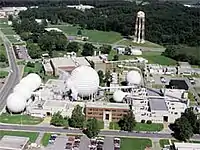


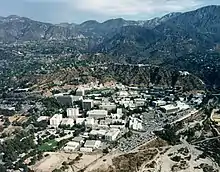
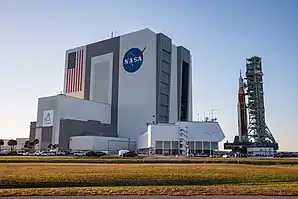
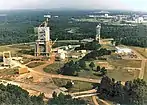
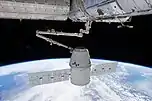
.jpg.webp)
.jpg.webp)
.jpg.webp)
_(cropped).jpg.webp)





.svg.png.webp)

